Samaaro + Your CRM: Zero Integration Fee for Annual Sign-Ups Until 30 June, 2025
- 00Days
- 00Hrs
- 00Min
In the last few years, the United Arab Emirates has become a worldwide destination for most world-class events, from trade expos to technology conferences to sports tournaments to cultural festivals. This rapid expansion is not accidental. It is supported by national initiatives like the UAE Vision 2031, a diverse and high-performing tourism economy, and an enabling business environment that welcomes brands from all over the world to engage with highly targeted and wealthy audiences.
As the event ecosystem matures, sponsorship has evolved from simple brand visibility to something far more strategic. It’s no longer about just placing a logo on a banner or a booth. In today’s competitive landscape, event sponsorship in the UAE is a dynamic tool for forming strategic partnerships, collaborations where both sponsor and host work together to create mutual value.
In reference to events, strategic partnership means developing beyond transactional sponsorships to co-created, goal-aligned partnerships, where brands and event organizers collaborate to deliver tailored experiences, activate audiences, and collectively deliver desired outcomes whether that’s customer acquisition, brand elevation, or community engagement.
These partnerships aren’t just a marketing play; they are a long-term growth lever. Especially in a region like the UAE, where scale, innovation, and global attention converge, there is significant opportunity for those who know how to develop this capability, robustly.
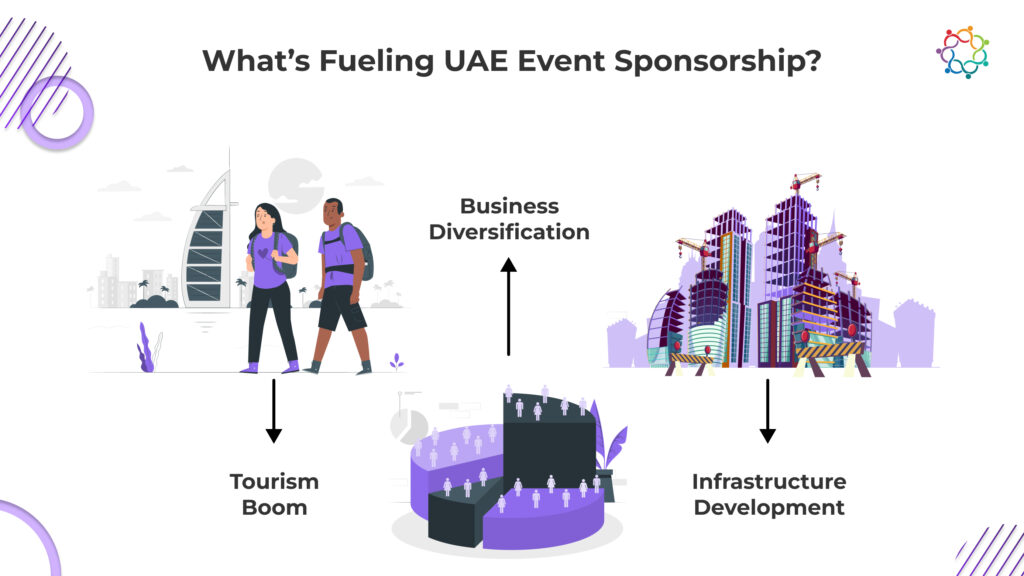
The events sector in the UAE is currently experiencing a golden age. The cities of Dubai and Abu Dhabi are spearheading the movement by investing ambitiously in world-class infrastructure, hospitality, and connectivity to support a thriving events calendar.
Several macro factors are fueling this growth:
From hosting the Global AI Summit to global music festivals, the Emirates has established itself as a hotspot for hosting events, which becomes an excellent launching pad for strategic sponsorships.
Event sponsorship in the UAE isn’t confined to just one domain. It spans across a range of high-growth sectors, each with unique audiences and brand alignment opportunities.
From GITEX Global to Arabian Travel Market, the UAE is home to some of the largest B2B expos in the world. These events are magnets for C-suite decision-makers, investors, and innovators, making them ideal grounds for tech companies, fintech players, and industry disruptors looking to establish credibility and generate leads.
The UAE is increasingly positioning itself as a regional sports hub, with global events like:
Sports sponsorships provide massive reach, international broadcast exposure, and premium on-site activations for lifestyle, luxury, and automotive brands.
Cultural and entertainment events such as the Dubai Shopping Festival and Abu Dhabi Film Festival provide sponsors with unparalleled opportunities to create meaningful emotional connections with audiences. These events are best suited for brands in the consumer goods, apparel, and consumer technologies sectors who want to bolster prominence among local and regional consumers.
These industries exemplify the variety and vibrancy seen within the UAE event landscape leading sponsors to ensure they can customize their approach taking into consideration each event’s purpose and audience.
Strategic event sponsorships in the UAE go far beyond logo placements and booth space. When designed thoughtfully, they offer tangible value for both sponsors and event organizers. Here’s how:
UAE events often attract hyper-relevant audiences, from C-suite executives at global tech summits to culture-conscious consumers at lifestyle festivals. Sponsors benefit from:
For organizers, strong sponsorships enhance event credibility and experience quality, making the event more attractive for attendees and media alike.
Live experiences create an opportunity for in-person interaction in a digital-first world. Sponsors can:
For hosts, sponsored activations increase attendee dwell time, create a better experience and enhance the memory of the event making it a better experience overall.
Sponsorships aren’t limited to the event venue. They often create deep content opportunities that continue to provide value long after the event:
This digital layer provides returns on investment (ROI) for both parties, especially in a content-driven economy like the UAE’s marketing economy.
It is indispensable for both domestic and international brands wishing to sponsor events in the UAE to understand the regulatory framework underpinning sponsorship. Nevertheless, the legislation is laid out simply in the UAE to promote brands and foreign investment in the events market.
The Department of Tourism and Commerce Marketing (DTCM) in Dubai offers structured sponsorship schemes for events that align with the city’s branding and tourism goals.
For sponsors, events supported by DTCM often signal a level of quality and legitimacy, making them more attractive opportunities to associate with.
The UAE has made significant progress in liberalizing business laws to attract international sponsors and event organizers.
This regulatory clarity has made it easier, and more appealing, for international sponsors to participate in the UAE event market with confidence.
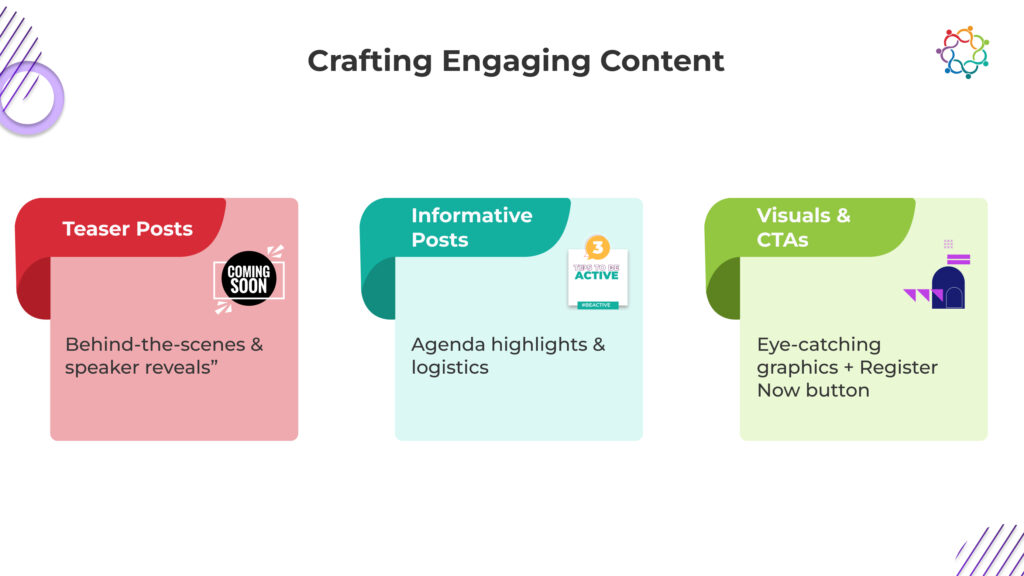
Not all sponsorships are created equal. The most impactful ones are the result of deliberate alignment, creative collaboration, and tailored execution. Here’s how to move from transactional deals to truly strategic partnerships.
Strategic sponsorships begin with shared purpose.
When brand and event narratives align, the impact is stronger and more memorable.
Gone are the days of one-size-fits-all sponsorship tiers. Today’s leading events offer flexible, creative packages that reflect each sponsor’s goals.
Sponsors should seek involvement in package design, rather than settling for predefined benefits. Co-creation ensures relevance and maximizes ROI.
In the UAE, where experiential occurrences are often in-person and digital, an experience activation can have lasting effects long after the experience has concluded.
Through an immersive and shareable experience, sponsors not only provide opportunities to enhance their brands visibility but also create a more engaging environment for the event.
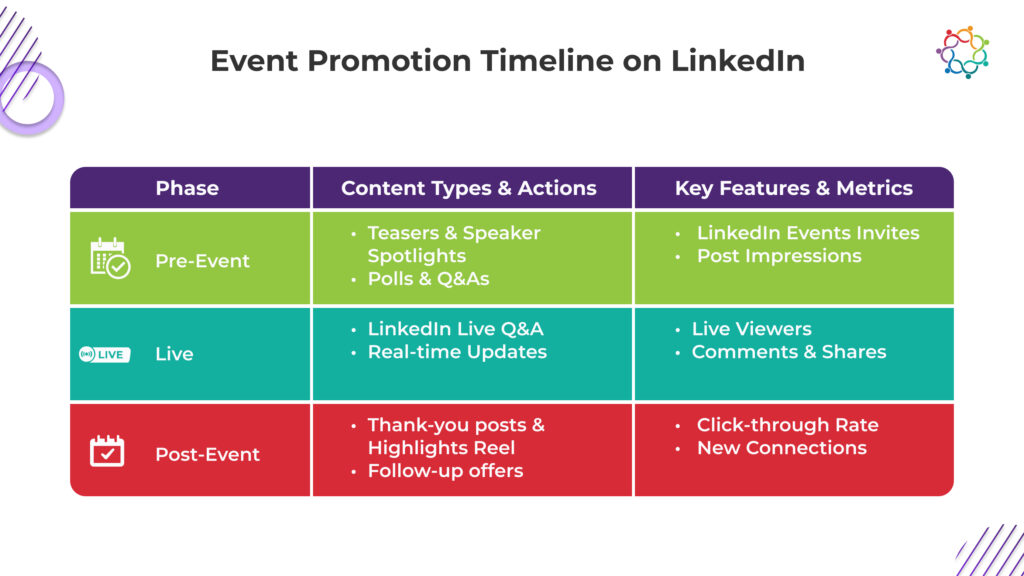
In a data-conscious landscape, the success of sponsorships must be quantifiable. While brand equity and awareness are important, sponsors and organizers alike need clear metrics to evaluate performance and justify investment.
Before the event begins, focus on awareness and anticipation:
Setting benchmarks early helps both parties evaluate whether the sponsorship is set up for success.
The event in and of itself provides an abundance of ways to be able to measure live engagement:
Real-time dashboards or mobile applications can facilitate sponsors and hosts measuring these metrics in real-time and can enable response, if necessary.
After the event, the focus shifts to outcomes and long-term impact:
This phase is critical, not only for reporting but also for iterating and improving future sponsorship efforts. A data-rich debrief sets the foundation for repeat, long-term partnerships.
As the sponsorship environment in the UAE grows more competitive, having a contract is not enough. Success is dependent on proactive foresight, being open and transparent, and being adaptable. Below are some practices that have been shown to maintain optimal alignment and effectiveness for both sponsors and organizers:
Strategic partnerships are not just about short-term visibility, they’re about long-term brand alignment and measurable value.
The UAE serves as an events hub in the region and global platforms for sponsorships that matter. With world-class infrastructure, government support, and a deeper and sophisticated audience, the UAE can provide a unique opportunity for sponsoring brands and event organizers to create meaningful sponsorship partnerships of lasting value.
By aligning brand values, creating customized sponsorship packages, creating technology, and measuring remarketing engagements, brands can do more than just show up, they can show impact. Organizers can build their event as a platform for commercial success and thought leadership for everyone.
This opens the door for a platform like Samaaro to return to sponsorships.
Samaaro helps event organizers control sponsorship from pre-planning events to post event reports. Samaaro has tools that manage branding, lead capturing, content sending, and measuring. Samaaro allows its sponsors and event hosts to create, manage, and measure their strategic partnership.
Whether you’re hosting or sponsoring, now’s the time to reimagine what strategic sponsorship looks like in the UAE, and Samaaro is here to help make that vision a reality.
According to the Sales Enablement Collective, organizations with a defined sales enablement function achieve a 49% higher win rate on forecasted deals. Meanwhile, 47% of event marketers say in-person events deliver the highest ROI of any channel, yet many companies still treat events and sales follow-up as separate silos, leaving revenue on the table.
Sales enablement is the strategic, ongoing process of equipping sales teams with the content, guidance, training, and tools they need to engage buyers effectively and close deals faster.
Event marketing is the experiential promotion of a brand, service, or product through memorable live or virtual events designed to engage audiences, foster relationships, and drive conversions.
When sales enablement and event marketing unite under a shared strategy, organizations can amplify ROI, improve lead quality, and accelerate sales velocity.
We’ll explore:
At their core, both sales enablement and event marketing strive toward the same overarching goals: accelerating the sales pipeline, deepening engagement with high-value accounts, and driving revenue growth. When these functions operate in silos, the impact of their efforts is often diluted. However, when aligned, the results can be transformative, organizations with strong sales and marketing alignment grow revenue 32% faster and achieve 36% higher customer retention compared to those without alignment.
Events, whether trade shows, roadshows, or executive roundtables, create rich opportunities for marketing and sales to work in concert. Marketing sets the stage by generating interest and delivering value-driven experiences. Sales, equipped with timely insights and content, can then build on this momentum with targeted conversations that move prospects swiftly through the funnel. When both teams share the same goals, whether that’s generating a certain number of qualified leads, booking meetings, or closing deals sourced from an event, they can align tactics, prioritize resources more effectively, and create a seamless prospect experience that maximizes conversion potential.
Traditionally, marketing and sales operate at different stages of the buyer journey, and often in different communication modes. Marketing typically focuses on one-to-many engagement, casting a wide net to attract and nurture prospects through content, campaigns, and events. Sales, meanwhile, executes one-to-one outreach, building personalized relationships with key stakeholders to convert interest into purchase decisions.
Without intentional collaboration, this division creates gaps: marketing may deliver leads that sales deem “unqualified,” or sales may miss opportunities to leverage marketing-driven content in their conversations.
Integrating sales enablement into event marketing breaks down these barriers:
When insights flow both ways, event experiences become not just marketing exercises, but strategic sales accelerators.
To fully capitalize on the synergy between sales enablement and event marketing, organizations must move beyond ad-hoc collaboration and develop a unified go-to-market charter. This charter outlines how marketing and sales will work together, before, during, and after events, to drive shared business outcomes.
Key elements of a unified charter include:
By owning joint KPIs, both teams are incentivized to collaborate continuously and measure success through the same lens.
By formalizing collaboration through a charter, marketing and sales transition from operating in parallel to working in true partnership, creating an integrated, high-performing revenue engine that fully leverages the power of events.
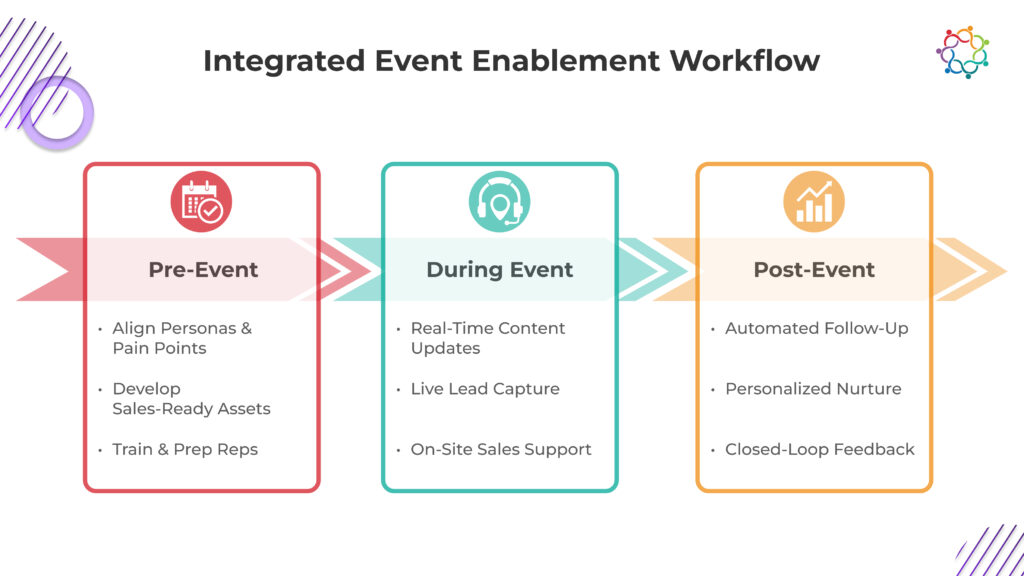
Effectively integrating sales enablement into event marketing isn’t just about working together, it’s about building a system that supports the full journey of a lead, from first interaction at the event to closed deal. Here’s how to build that system across every phase:
Sales Input into Event Planning
Sales teams are on the front lines, constantly interacting with prospects and hearing firsthand their needs, challenges, and objections. Before any event, it’s crucial to tap into this intelligence. Organize collaborative workshops where sales can share updated buyer persona insights, the latest pain points emerging in conversations, and critical objections prospects raise. This information should directly inform the event’s session topics, speaker selection, messaging frameworks, and booth materials. When event content mirrors real-world buyer concerns, it’s far more likely to drive engagement and pipeline impact.
Develop Event-Specific Sales Assets
Generic brochures and one-size-fits-all presentations won’t cut it for strategic events. Ahead of each event, create custom talking points, FAQ sheets, product demos, and quick-reference materials that reflect the event theme and audience’s priorities. Design digital leave-behinds (such as product one-pagers, customer success stories, or demo videos) that sales can quickly send after conversations. These resources should act as bridges between the excitement of the event and the deeper buying discussions that happen afterward.
Train Sales Reps on Event Goals
Your sales team should never arrive at an event unsure of what success looks like. Host pre-event workshops or virtual briefings to align everyone on key goals, such as the number of qualified conversations or meetings booked. Define attendee segments (e.g., VIP prospects, target accounts) and clarify lead qualification criteria. Role-play common booth scenarios to help reps practice introductions, qualifying questions, and smooth transitions into follow-up conversations. The better prepared the sales team is, the more impactful every attendee interaction will be.
Pre-Event Outreach
Waiting until prospects walk up to the booth is a missed opportunity. Arm your sales teams with pre-written email templates and LinkedIn messaging scripts that they can personalize and send to registered attendees before the event. Encouraging reps to book meetings in advance not only increases on-site engagement but also boosts the overall return on investment by focusing efforts on high-value prospects. Personalized pre-event outreach can significantly improve booth traffic quality and shorten post-event sales cycles.
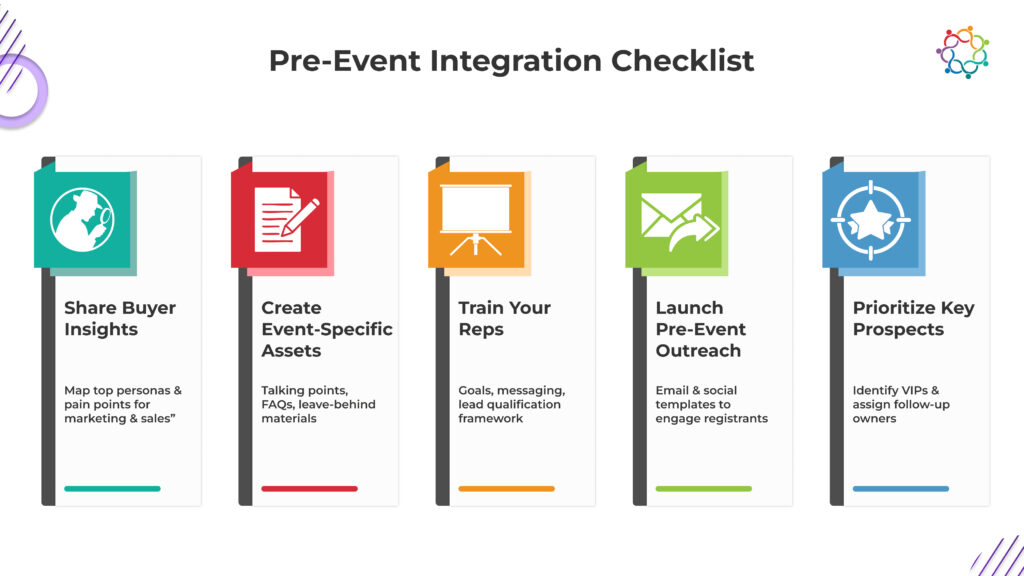
Real-Time Content Sharing
Events are dynamic, and plans often evolve on the ground. Product updates, schedule changes, or new talking points can arise. Create real-time communication channels, like a dedicated Slack workspace or a mobile app, so marketing can instantly push updates to the sales team. This ensures everyone is delivering the most current information during conversations with prospects.
Coordinated Engagement Roles
Clearly define roles and responsibilities for the sales and marketing teams before the event starts. Assign who will manage demos, who will handle meeting bookings, who will be responsible for scanning badges, and who will collect qualitative feedback. This division of labor prevents confusion, ensures no opportunity is missed, and creates a seamless experience for attendees moving through the booth or event space.
Seamless Lead Capture and Qualification
Forget business cards and manual note-taking. Implement digital lead capture tools like QR code scanning, mobile forms, or badge scanning apps that sync directly with your CRM system. Design your lead capture forms to include key qualification questions (such as budget, timeline, and decision-making authority) so sales reps can prioritize follow-up efforts immediately after the event. The goal is to achieve 100% lead data capture, clean, complete, and actionable, without burdening the onsite team with administrative tasks.
Event Content in Sales Conversations
Leverage event programming to enrich sales conversations. Equip your reps with strategies to reference keynote sessions, panel discussions, or workshops when speaking to prospects. For example, a rep might say, “As you heard in the opening keynote, digital transformation is reshaping procurement, let me show you how our platform directly addresses that shift.” This positions your team as knowledgeable and aligned with industry trends, enhancing credibility.
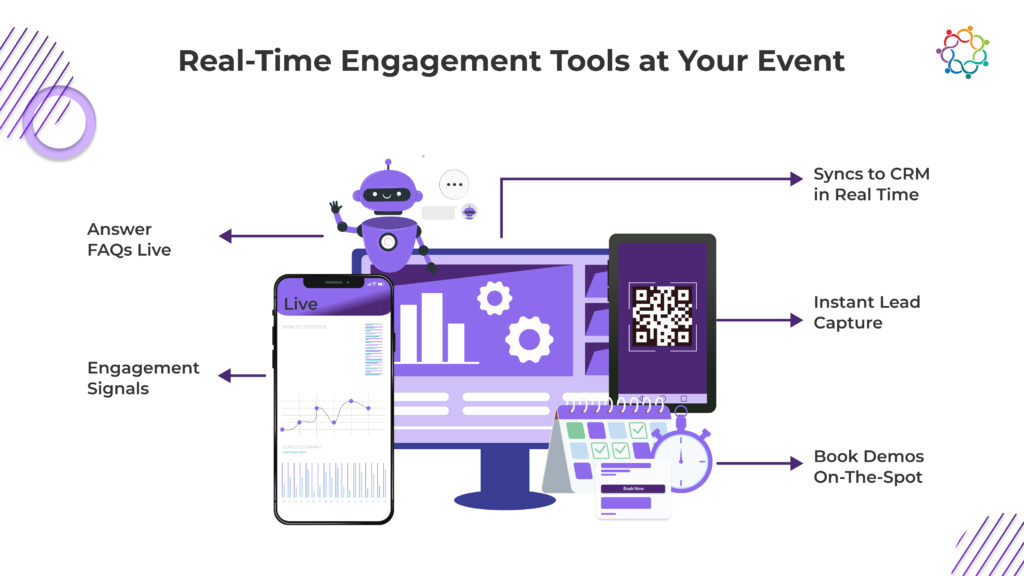
Prompt, Personalized Follow-Up
The first 48 hours after an event are critical. Leads are warm, memories are fresh, and competitors are also reaching out. Provide your sales reps with personalized follow-up toolkits, pre-approved email templates, session recordings, key presentation decks, and follow-up guides tailored to attendee interactions. Personalization is key here: a generic “Thanks for stopping by” email won’t stand out. Mention specific sessions attended, conversations had, or interests expressed.
Lead Nurturing Campaigns
Not every lead will be ready to buy immediately. Build segmented nurturing workflows based on event engagement. For example, send product deep-dive resources to booth visitors, educational content to session attendees, and case studies to those who requested demos. Automation can help maintain momentum without overwhelming the sales team. Personalization based on interaction history keeps your brand top-of-mind until leads are ready to move forward.
Sales Debrief and Feedback Loop
Immediately after the event, gather your sales team for a structured debrief. Discuss:
Measuring Impact
Track and analyze key performance indicators (KPIs) to evaluate the effectiveness of your integrated approach:
These metrics not only demonstrate ROI but also highlight where further improvements can be made.
The success of integrating sales enablement and event marketing hinges not just on execution, but on how effectively you measure impact. Without a data-driven approach, it’s nearly impossible to identify what worked, what didn’t, and where to improve. By tracking the right metrics and using the right tools, teams can close the loop between event execution and revenue generation.
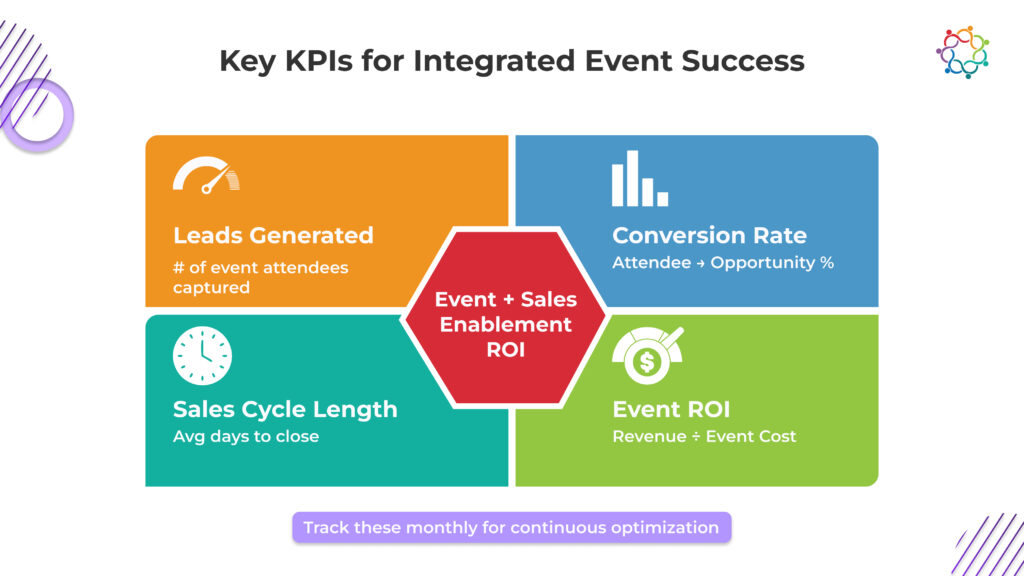
To assess the effectiveness of your integration strategy, consider KPIs across multiple dimensions: pipeline contribution, sales efficiency, team collaboration, and overall return on investment.
This is your foundational metric, the raw count of individuals who engaged with your brand at the event. But don’t stop at just collecting contact details. Segment leads by type (e.g., booth visitor, session attendee, demo participant) to better understand where engagement occurred and which touchpoints were most effective.
Volume alone doesn’t tell the full story. Quality matters even more. Work with sales to assess whether event leads align with your ideal customer profile (ICP) and how likely they are to convert. Are these decision-makers? Do they have active pain points? Lead scoring models and qualification criteria should be applied here, enriched by feedback directly from the reps who engaged them.
Track how many event leads progress through the sales funnel, from marketing-qualified leads (MQLs) to sales-qualified leads (SQLs), to opportunities, and ultimately to customers. This metric is one of the most telling indicators of how well your event strategy and sales enablement materials are aligned. A spike in early conversions may point to strong pre-event alignment; longer-term conversions might highlight effective nurturing.
Compare the average sales cycle for leads sourced from events versus other channels. A shorter cycle suggests that your event provided high-value interactions that accelerated decision-making. If the cycle is longer, it may signal the need for better follow-up content or lead nurturing strategies.
Perhaps the most tangible metric, revenue attribution helps quantify the real business impact of your event efforts. Track closed-won deals that originated from event engagements, and tie them back to specific touchpoints, was it the keynote session that sparked interest, or the one-on-one booth demo that sealed the deal?
Post-event surveys or informal interviews with the sales team can uncover whether they felt equipped to engage attendees effectively. Were the talking points helpful? Did they receive timely updates and follow-up materials? Their feedback is essential to improving future integrations.
Just as sales relies on marketing for high-quality content, marketing depends on timely and personalized follow-up. Ask your marketing team whether the sales team used the materials provided, followed up with leads within the ideal time frame, and reported back outcomes. Misalignment here could point to a breakdown in communication or accountability.
At the highest level, calculate the return on investment for your event efforts. Factor in all associated costs, venue, booth design, travel, staff time, technology, and compare it against total pipeline generated and actual revenue closed. ROI helps justify future event spend and signals the value of integration efforts.
The right tech stack is essential for tracking these KPIs accurately and consistently. Here’s a breakdown of the key tools to consider:
Your CRM acts as the central source of truth for all lead and opportunity data. Systems like Salesforce, HubSpot, or Zoho allow you to attribute leads to specific events, track their journey through the pipeline, and measure conversion and revenue metrics. Make sure event data is tagged appropriately so you can filter and analyze it later.
Platforms like Marketo, ActiveCampaign, or Mailchimp help you run lead nurturing campaigns and monitor engagement post-event. These systems are particularly useful for segmenting leads based on event interactions and delivering personalized follow-ups.
Dedicated tools for event registration, badge scanning, session tracking, and lead capture (like Samaaro) help streamline attendee data collection. When integrated with your CRM, these tools ensure no data is lost between the event floor and your sales pipeline.
Visualization platforms like Tableau, Power BI, or the analytics modules within your CRM can be used to create dashboards that combine sales, marketing, and event data. This allows stakeholders to monitor performance in real-time and uncover trends, such as which sessions generate the most SQLs or which event formats drive higher ROI.
Measuring integrated efforts isn’t just about proving ROI, it’s about refining your go-to-market engine. Every data point helps you optimize content, improve team collaboration, and build better events. By establishing a repeatable framework for measurement, organizations can turn every event into a smarter, more revenue-focused endeavor.
Bringing together sales enablement and event marketing may sound straightforward on paper, but in practice, it often involves untangling misalignments, habits, and systems that have developed independently over time. While the rewards of integration are substantial, it’s important to anticipate common hurdles and proactively address them.
The Challenge:
Marketing and sales teams often operate in silos, with limited visibility into each other’s goals, strategies, and feedback loops. This disconnect leads to missed opportunities: marketing may generate leads that sales isn’t prepared to act on, or sales may not follow up in ways that reflect the event’s messaging.
How to Overcome It:
The Challenge:
Sales might view events purely as lead-generation opportunities, while marketing sees them as brand-building platforms. Without shared goals, success is defined inconsistently, making post-event evaluation difficult and collaboration strained.
How to Overcome It:
The Challenge:
Integrating efforts requires time, tools, and people, from enabling technologies to sales training. Without proper investment, teams may default to operating in isolation.
How to Overcome It:
The Challenge:
Marketing and sales teams often use different systems, event tools, CRMs, automation platforms, that don’t naturally talk to one another. This can result in data fragmentation, delays in follow-up, and reporting blind spots.
How to Overcome It:
The Challenge:
People are often hesitant to shift away from familiar workflows, even if they’re inefficient. Sales reps might be wary of new follow-up processes, while marketing teams might be reluctant to rely on sales input during event planning.
How to Overcome It:
Every challenge is also an opportunity to strengthen alignment and drive better results. By acknowledging potential roadblocks and proactively creating solutions, organizations can foster a culture of collaboration that makes every event more impactful, and every lead more valuable.
The evolving landscape of B2B engagement calls for more than just great events or polished sales pitches—it demands cohesion. When sales enablement and event marketing operate as one, the results are undeniable: stronger pipelines, faster conversions, and a unified customer journey that drives meaningful revenue impact.
Success lies not in one team outshining the other, but in both teams moving in sync—from event planning to post-event pipeline acceleration. Integration isn’t a one-time project—it’s an ongoing mindset shift. It means committing to regular feedback, shared tools, and mutual accountability.
At Samaaro, we believe that events should be a strategic growth channel—not an isolated activity. That’s why our platform is built to empower marketing and sales teams to collaborate more effectively. From real-time lead capture and centralized attendee data to seamless integrations with your CRM and marketing automation tools, Samaaro ensures that every event drives measurable sales impact.
We’re not just helping you host better events—we’re helping you close better deals.
Ready to integrate your event marketing with sales enablement?
Referral programs are quickly becoming one of the most significant organic marketing strategies for event registration. In the UAE, where interpersonal networks and trust factor heavily into decision making, a referral program will help grow attendance while lowering acquisition costs.
Event planners must leverage the connectors in the digital space and understand there is a desire for exclusive experiences in driving attendance in the UAE. Using the right incentives, tracking, and promotional strategies, event planners can help facilitate converting attendees to evangelists about the event—in turn helping to keep the event going.
This guide will look at:
Let’s get into the strategies to help you create impactful referral activity for your next event.
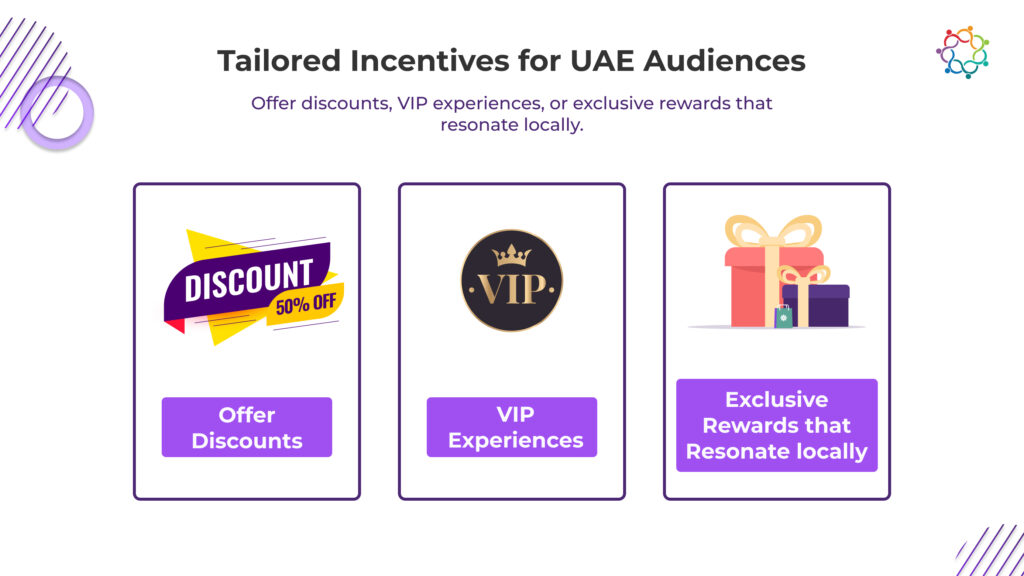
The UAE has a highly diverse population, with a mix of expatriates and local Emiratis who have different preferences when it comes to incentives. To create an effective referral program, it’s essential to align incentives with cultural expectations and consumer behavior.
Key factors influencing referral incentives in the UAE:
Several events and brands have leveraged referral incentives effectively:
When designing incentives, it’s important to ensure they are proportional to the value of the event itself.
By tailoring incentives to the preferences and expectations of UAE audiences, event organizers can build a referral program that drives organic registrations, enhances brand loyalty, and maximizes engagement.
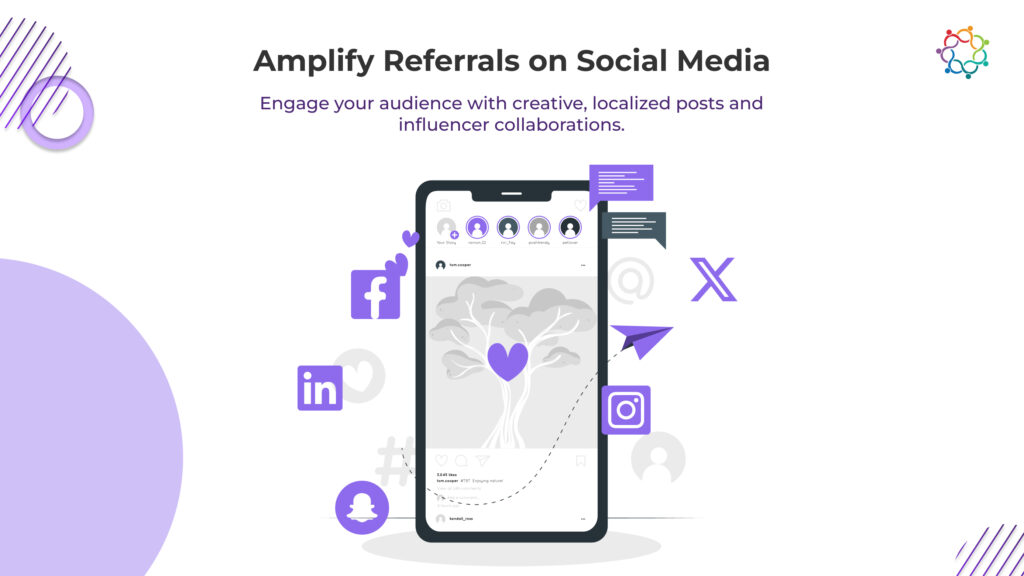
The UAE has one of the highest social media penetration rates globally, making platforms like Instagram, Facebook, LinkedIn, Snapchat, and TikTok powerful tools for referral program promotion. Choosing the right platform depends on your target audience:
To drive referrals, content should be engaging, shareable, and action-oriented.
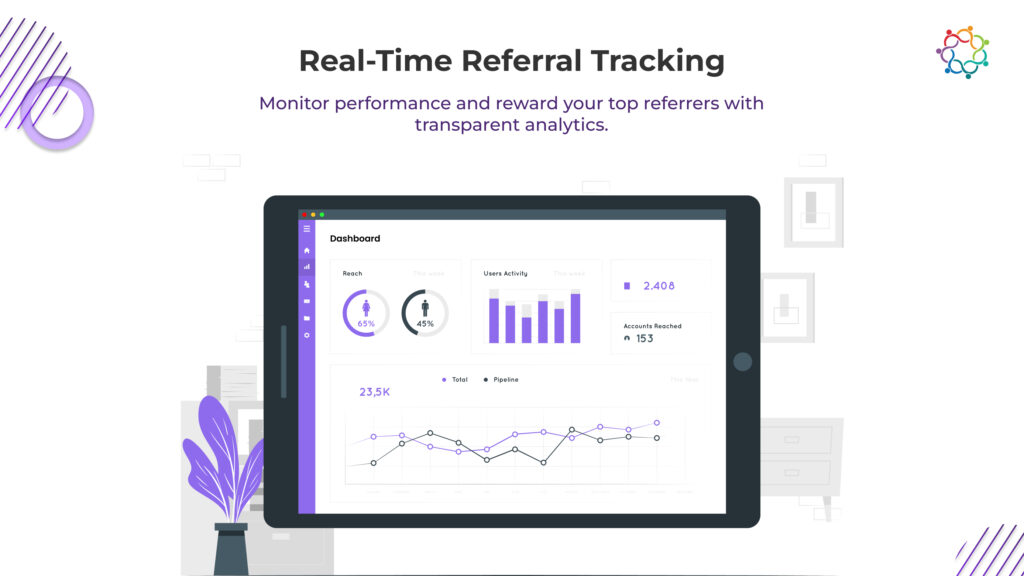
Analyzing results and metrics To determine how well your referral program is functioning, it is helpful to track the key performance indicators (KPIs) you established previously:
Reward system:
an effective reward system should be simple, easy to work with, and attractive enough to motivate people to refer others.
You may want to consider:
Tracking and integration Referral Tracking Tools:
By combining strategic social media promotions with robust tracking and rewards, your referral program can drive strong organic registrations while enhancing attendee engagement.
4. Referral Community within the UAE Business Sector Networking Strategies:
Captivating Key Industry Players & Business Associations The ecosystem of business in the UAE is built on established networks and professional relationships; therefore, if event planners want to have a successful referral program they must endeavor to engage the key stakeholders, business leaders and associations who can promote referrals.
Key Methods for Working with Business Associations:
Business Chambers, such as Dubai Chamber of Commerce, Abu Dhabi Chamber, or working with TECOM Business Communities, provide outlets for gathering professionals from the same industry to connect and network. If you partner with any of these groups, it can help facilitate your outreach efforts.
Community Engagement – Building Brand Advocates to Continue Promotion
Beyond formalised networking, you can build a community of people that are enthusiastic about referral success. Examples include:
Creating Groups for Referrers Determine to create a WhatsApp or Telegram group for your referrers and be sure to highlight the connections that they make when the events happen (but make it exclusive to those).
Recognizing and Appreciating Active Referrals Recognizing top referrers in event communications (e.g. social media or newsletters) or offering a limited number the chance to engage other VIP speakers are wonderful ways to recognize their support.
Pre-Event Meetups or Webinars
You can further create engagement and deepen referral networks by holding very informal, small networking meetups ( or webinars if you are not in the area) or hosting industry panel discussions before your event.
Establish an Ambassador Program
Curate a rotating list of loyal attendees and industry influencers who will be long-term brand ambassadors of your event and support the event among their professional community.
Amidst strategic networking and building community offers better sustainability for event organizers to have an ongoing and solid referral network that can continue to grow organically for ongoing events.
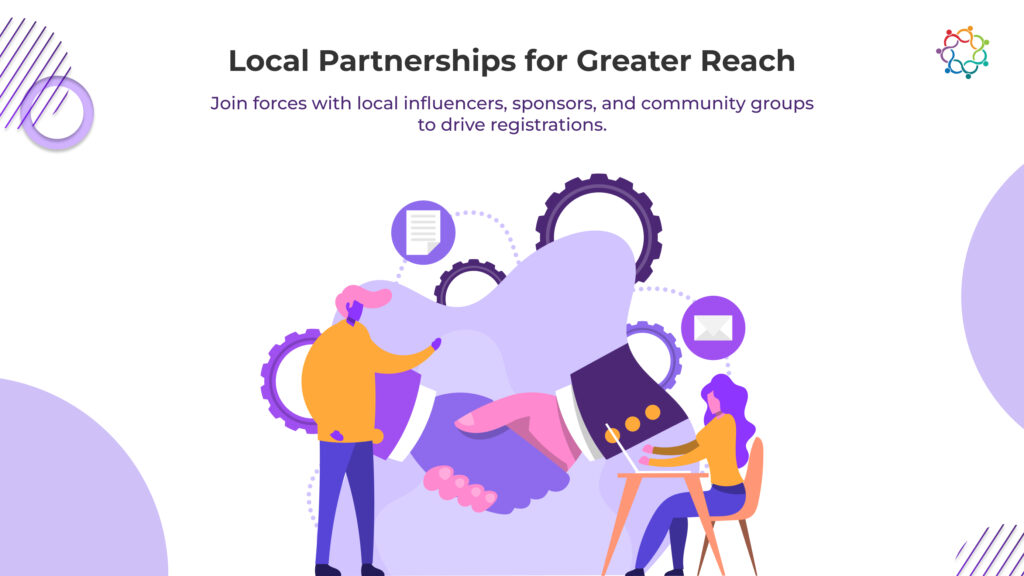
Identifying Partnerships to Generate Referrals Identifying and working with engaged local partners can also create significant success for your referral program. Some possible partners could include:
Corporate Sponsors or Industry Leading Corporations
Identifying and working with industry leading corporations,
Some great examples include the Khaleej Times, Gulf Business, or Entrepreneur Middle East any participants in your RMP can target and amplify an outreach campaign.
Universities or Learning Institutions If your a career expo, industry specific conference, or startup event advocating education in the UAE are important.
Partnership Models of Working Agreements for Referrals
To avoid and ensure mutually beneficial relationships when developing event partnerships employs the below models:
By using local partners, organized about the event can max out their local referrals and helping co-create growth sustainability into scheduling for the local UAE region for an event series, organized about the same focus (ie. referral support).
A well-executed referral program should not function in isolation—it should be seamlessly integrated into your overall event marketing strategy. By aligning referral efforts with email marketing, content marketing, and paid social campaigns, event organizers in the UAE can maximize reach and engagement.
To ensure a cohesive event promotion plan, referral initiatives should be embedded within multiple marketing touchpoints:
To evaluate the effectiveness of referrals in the overall marketing mix, event organizers should track:
Implementing UTM parameters, custom tracking links, and integrated CRM dashboards helps assess referral performance alongside other promotional efforts.
The UAE’s digital-first audience is rapidly adopting new referral strategies driven by:
With the rise of localized digital campaigns, referral marketing will continue to play a vital role in driving high-quality, organic event registrations.
A strong referral program can significantly boost event registrations in the UAE when combined with strategic planning and execution. The key takeaways include:
By implementing these best practices, event organizers can unlock sustainable organic growth while increasing brand engagement and attendance.
Samaaro is a trusted event management platform used by leading brands in the UAE to streamline event operations and enhance audience engagement. With seamless integration into referral and promotional strategies, Samaaro empowers organizers to drive maximum registrations and execute successful, high-impact events.
Influencer marketing has emerged as a powerful tool for event promotions in the UAE, where digital engagement plays a crucial role in audience outreach. With a high social media penetration rate, businesses are increasingly turning to local influencers to drive event registrations and build community engagement.
However, the UAE’s digital landscape is unique, requiring localized influencer strategies that align with cultural, legal, and platform-specific preferences. In this guide, we will explore:
By the end of this guide, you will have actionable insights to successfully integrate influencer marketing into your event promotion strategy in the UAE.
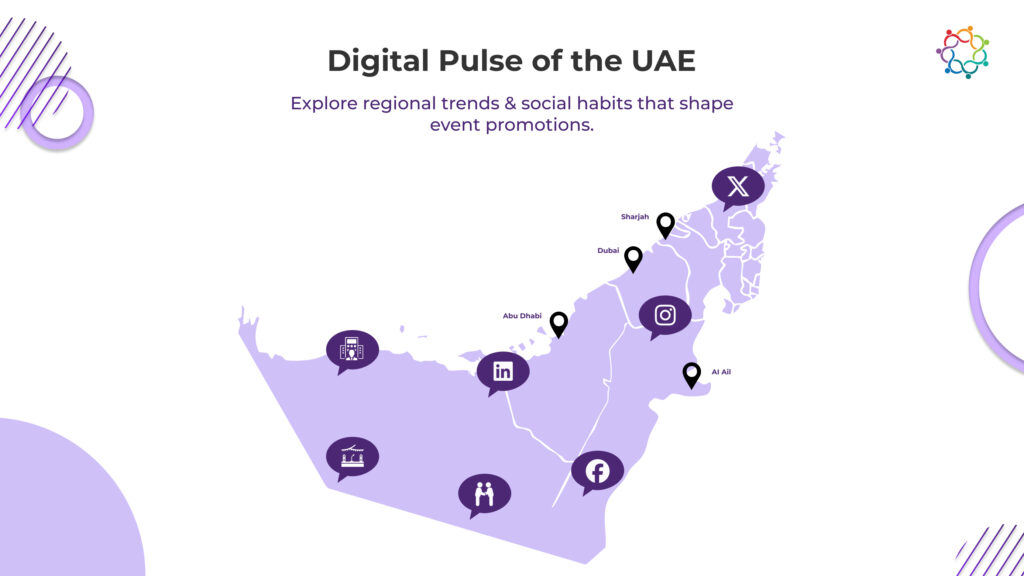
The UAE boasts one of the highest social media usage rates in the world, making influencer marketing a key strategy for driving event registrations. However, success requires a strong understanding of digital habits, platform preferences, and cultural nuances in the region.
By understanding these factors, event organizers can tailor influencer partnerships and campaign strategies for maximum impact in the UAE market.
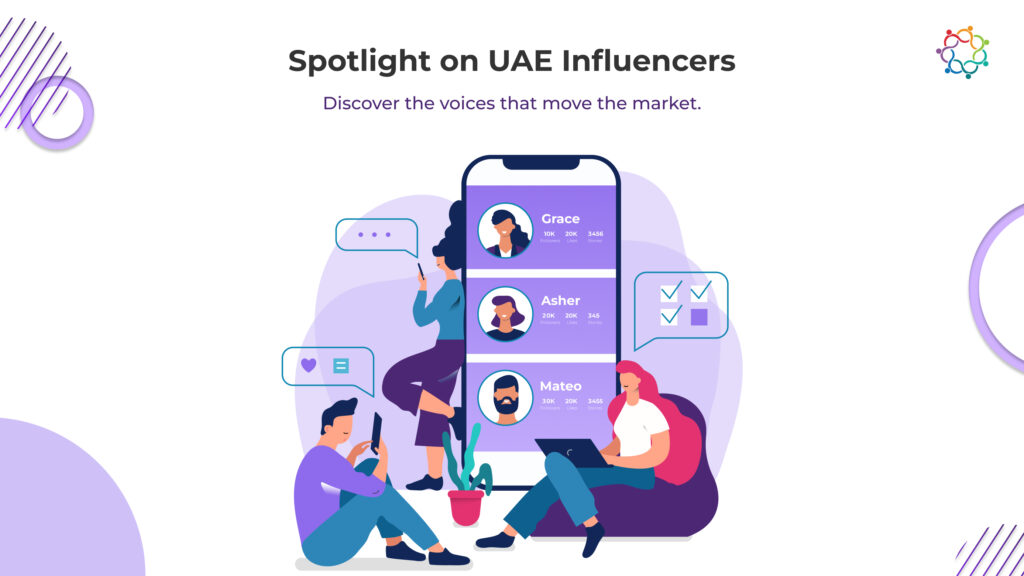
Selecting the right influencers for event promotion in the UAE requires a strategic approach, ensuring that partnerships drive authentic engagement and conversions. Not all influencers are equally effective—relevance, credibility, and audience alignment play a crucial role.
Partnering with influencers who resonate with UAE’s audience ensures greater visibility, trust, and higher event registrations.
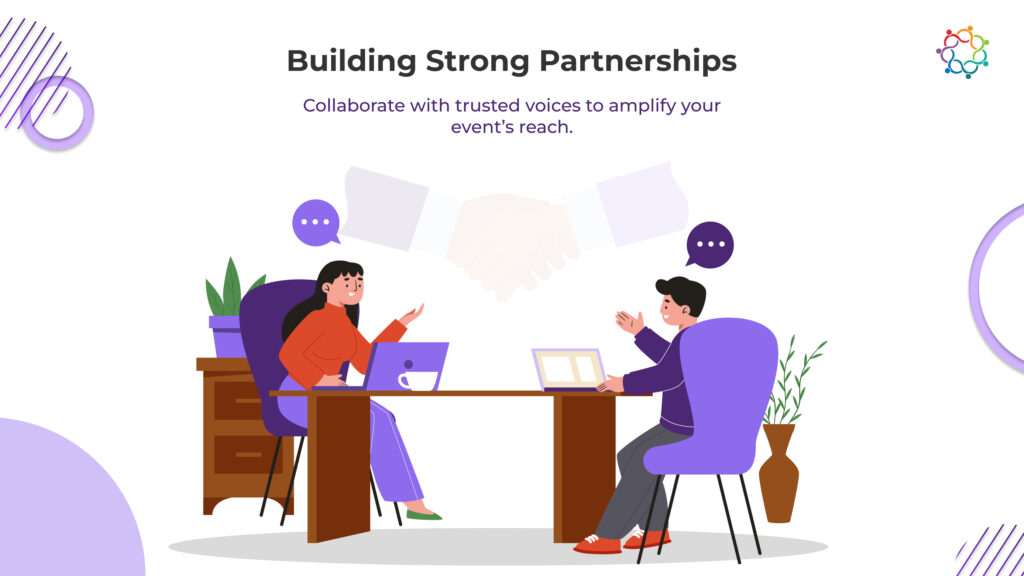
Once the right influencers are identified, the next step is to establish strong, mutually beneficial partnerships that yield measurable results.
By strategically selecting, collaborating, and measuring influencer partnerships, event organizers in the UAE can maximize brand exposure, credibility, and attendee conversions.
Influencer-generated content plays a critical role in event marketing , offering an authentic, engaging, and highly shareable way to drive registrations. The key is to strategically integrate influencer content across multiple marketing channels while ensuring strong calls to action that convert followers into attendees.
Influencer-generated content, when strategically aligned with event goals, can significantly boost brand awareness and ticket sales in the UAE market.
The UAE has strict influencer marketing regulations designed to ensure transparency, ethical practices, and compliance with cultural values. Understanding these guidelines is essential for running a successful influencer campaign while maintaining brand credibility and avoiding legal risks.
By following legal guidelines, respecting cultural sensitivities, and maintaining ethical standards, brands can build successful, compliant influencer campaigns that resonate with UAE audiences while avoiding legal complications.
6. Integrating Influencer Marketing with Overall Event Promotion Strategies
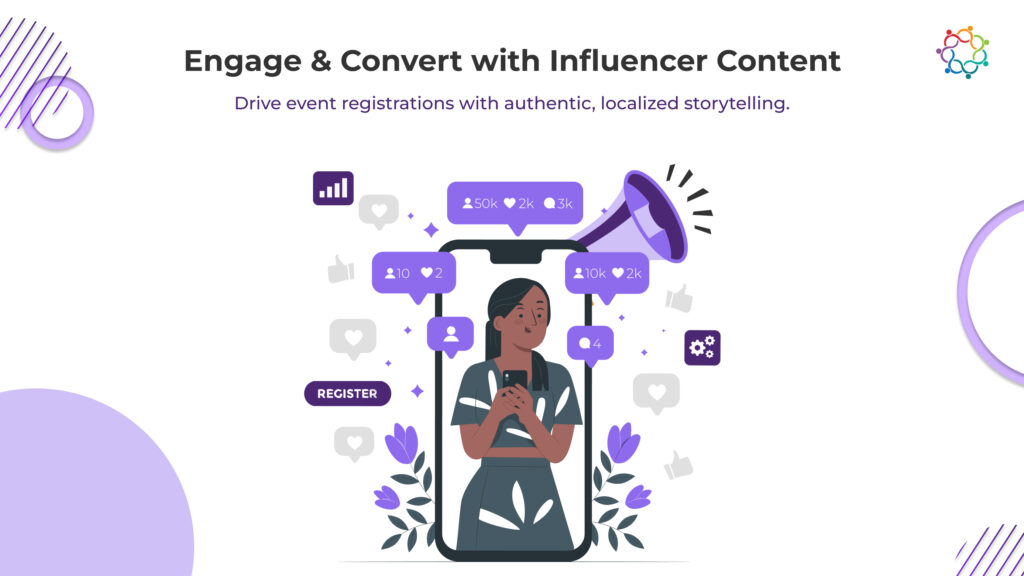
Influencer marketing is a powerful tool, but its effectiveness is maximized when integrated into a broader, multi-channel event promotion strategy. By combining influencer efforts with digital ads, email marketing, content marketing, and organic social media, event organizers can create a cohesive, high-impact campaign that drives registrations and engagement.
By strategically integrating influencer marketing with digital advertising, content marketing, and email campaigns, event organizers can maximize registrations, enhance audience engagement, and achieve long-term event success.
Influencer marketing has become a crucial component of event promotion in the UAE, helping brands reach engaged, trust-based communities. The key strategies discussed include:
For event organizers in the UAE, influencer marketing presents an unparalleled opportunity to connect with targeted audiences, enhance brand credibility, and increase registrations. By implementing these strategies, brands can elevate their event marketing efforts and ensure long-term success.
Samaaro is a leading event marketing platform, trusted by top brands in the UAE to streamline event promotions and maximize audience engagement. With advanced features that integrate seamlessly with influencer-driven strategies, Samaaro empowers event organizers to boost registrations, track campaign performance, and enhance audience experiences. Partner with Samaaro to unlock the full potential of influencer marketing for your next event.
WhatsApp has emerged as the principal communication mechanism in India, facilitating both social and work communication. Uniquely positioned with over 500 million users, WhatsApp provides event promoters with a direct, low-cost, and high-engagement medium to drive registrations. From a corporate summit to a trade exhibition to a cultural festival, WhatsApp groups allow event promoters to create tailored messages that can reach multiple audiences quickly and efficiently.
This blog will cover key strategies to help event organizers:
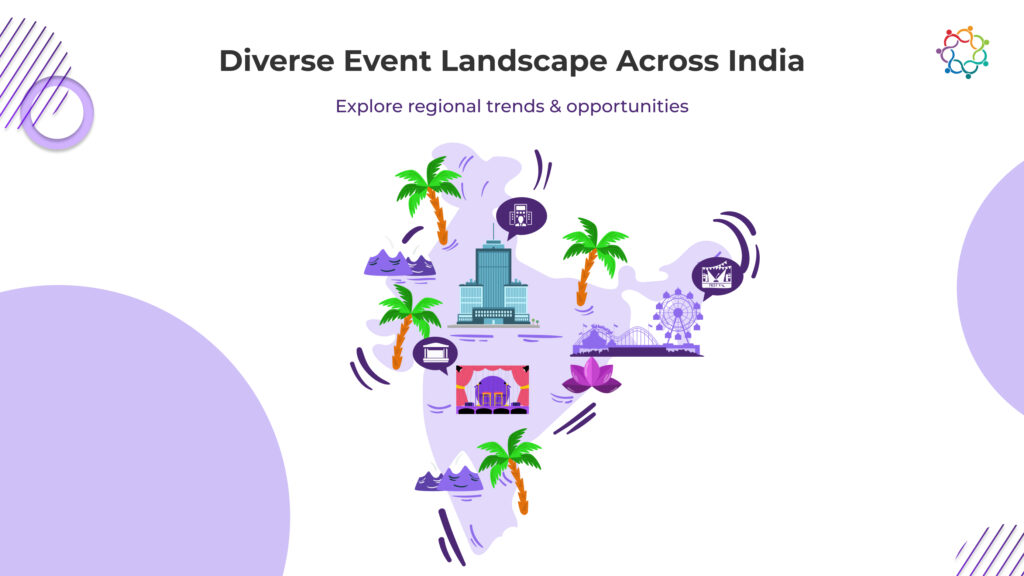
India’s event industry is one of the largest and most dynamic in the world, with a projected market size of over $9 billion by 2025. It encompasses a wide spectrum of events, including:
As digital adoption accelerates, the way events are promoted and marketed has changed significantly. Traditional methods like emails and social media ads alone are no longer enough—audiences expect more direct, real-time, and engaging communication, making WhatsApp a critical event promotion tool.
Mobile-First Audience Engagement
There are over 1.2 billion mobile phone users in India, and WhatsApp has penetrated more than 85% of the smartphone market. This makes it far more effective than any direct channel for event promotions, far exceeding email open rates and social media reach.
Regional and Vernacular Language Growth
Over 50% of Indian internet users prefer consuming content in regional languages. WhatsApp allows event marketers to create localized and multilingual campaigns, making it easier to engage audiences in Tier 2 and Tier 3 cities, where event participation is growing rapidly.
Rise in Hyper-Personalized Event Marketing
People today expect personalized live events, and mass broadcasting now is ineffective. Event organizers can leverage WhatsApp’s group segmentation, and one-on-one messaging to provide personalized promotional outreach, invitations, and consider event registration (RSVPs) by enabling a direct channel of interaction with potential attendees.
The Need for Instant and Interactive Communication
Unlike emails, which have an average open rate of 20-30%, WhatsApp messages see read rates as high as 98%. Features like instant messaging, voice notes, and multimedia sharing make it easier to:
| Challenges | Opportunities with WhatsApp |
| High competition for audience attention. | Direct, one-on-one communication ensures higher engagement. |
| Managing diverse regional audiences. | WhatsApp supports regional language messaging for better reach. |
| Low email and social media engagement. | WhatsApp boasts higher open and response rates. |
| Difficulty in tracking attendee interest. | Group interactions and read receipts offer real-time insights. |
Understanding these trends and challenges helps event organizers effectively leverage WhatsApp to boost registrations, enhance engagement, and build stronger attendee relationships in India’s evolving event landscape.
What sets WhatsApp apart is that it has over 500 million active users in India, it is more than a messaging application, it’s often a communication tool used by businesses, communities, and event organizers. Compared to emails or old-fashioned advertisements, WhatsApp’s level of real-time, direct and hyper-personalized engagement sets the stage for effectively promoting events.
Key advantages of WhatsApp for event marketing in India:
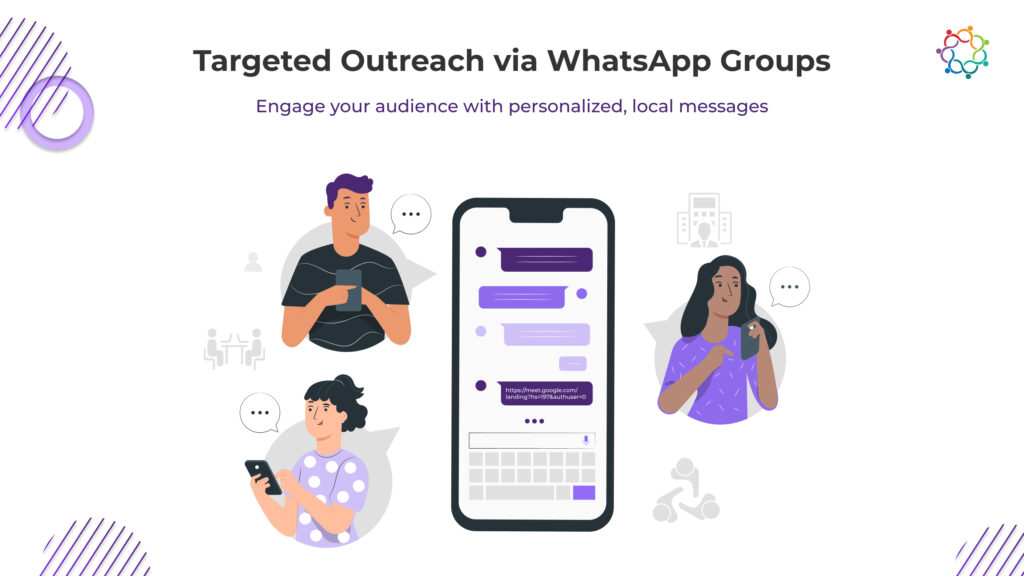
In order to optimize event sign-ups, organizers should segment their WhatsApp groups thoughtfully as opposed to using broadcast messaging. When participants begin to tailor messages for their groups instead of segmenting, more engaging event notifications.
Here are some practical segmentation strategies:
| Segmentation Type | How It Helps | Example |
| By Interest | Ensures content relevance and engagement | Separate groups for tech conferences, cultural festivals, or business networking events. |
| By Geography | Targets location-specific attendees | City-based groups (Delhi, Mumbai, Bangalore) for regional meetups. |
| By Audience Type | Allows for tiered messaging | VIP attendees, exhibitors, sponsors, and general attendees get different updates. |
| By Engagement Level | Prioritizes highly interested participants | Groups for early registrants or repeat attendees to offer special incentives. |
For one-to-one event promotions without creating multiple groups, broadcast lists can be highly effective. Unlike groups, messages sent via broadcast lists appear as personal messages in the recipient’s inbox, increasing response rates.
Best practices for using WhatsApp Broadcast Lists:
By combining targeted WhatsApp groups with personalized broadcast lists, event organizers can create a structured and highly effective promotional strategy.
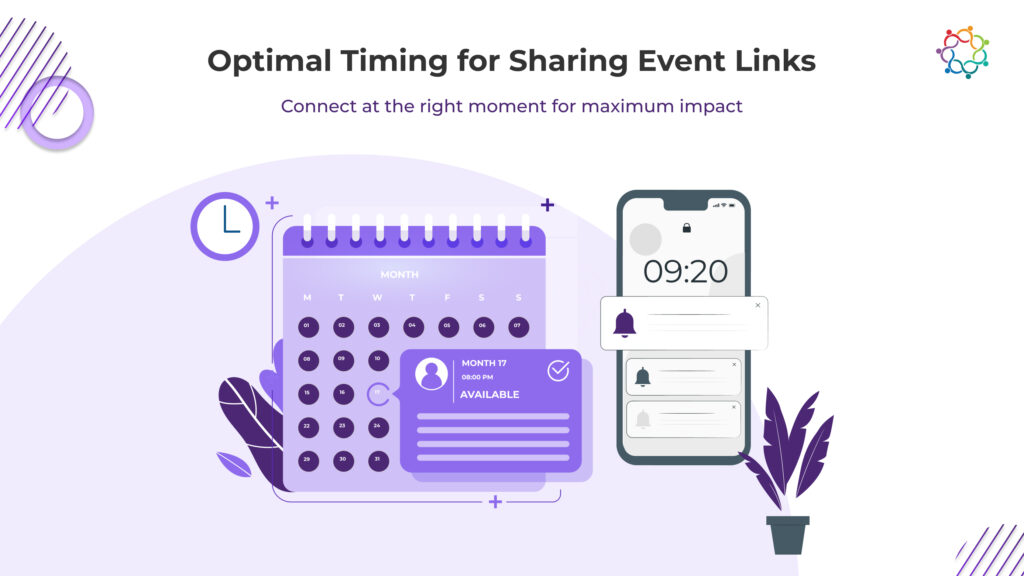
The timing of your messaging in relation to the events you produce is evident and will help garner engagement and registrations. In India, the pulse of daily life and culture will change its tempo when users engage with your messages via WhatsApp.
A compelling WhatsApp message can significantly boost registrations. Here’s how to create engaging and effective messages:
To refine messaging strategies, A/B testing can help determine what works best for different audience segments.
By monitoring click-through rates and engagement levels, organizers can continuously optimize their WhatsApp campaigns for better performance.
Influencer marketing in India has expanded rapidly, and local influencers are integral to event promotions. As they connect with their local communities in a deeper, more trusted, way than national celebrities do, there is greater authenticity in their promotion of events, resulting in greater engagement and conversions.
Influencer marketing has grown significantly in India, with local influencers playing a crucial role in event promotions. Unlike national celebrities, regional influencers have a strong, trusted connection with their local communities. When they endorse an event, it carries more credibility and leads to higher engagement and conversions.
Many brands and event organizers have leveraged WhatsApp and influencer marketing for successful promotions. For example:
By integrating local influencers into WhatsApp campaigns, event organizers can expand their reach, boost credibility, and drive higher conversions in regional markets.
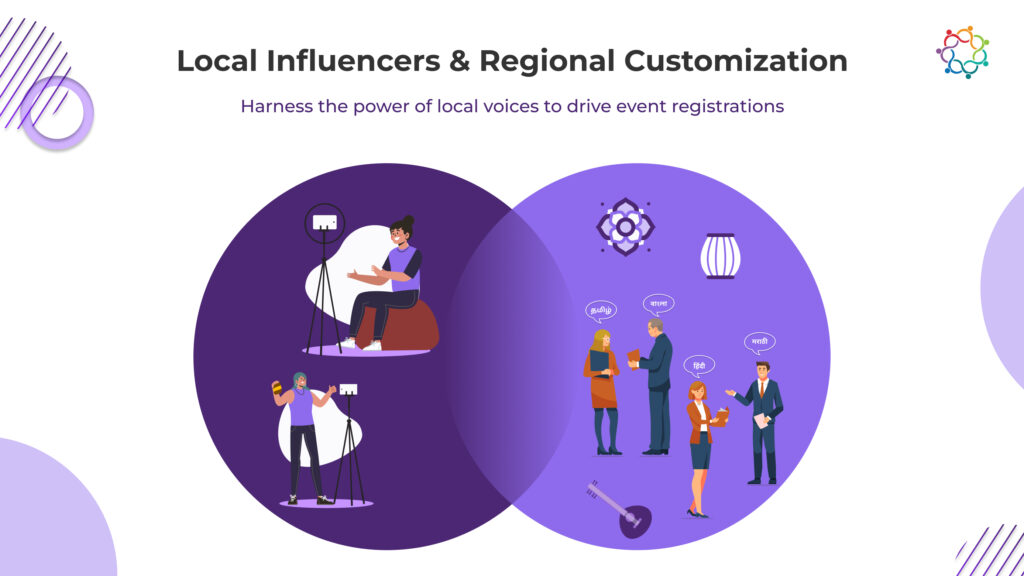
India’s diversity extends beyond language—it includes cultural practices, communication preferences, and digital behaviors, all of which influence how people respond to event promotions. A one-size-fits-all strategy won’t be effective when marketing across different states.
For instance:
By adapting WhatsApp promotions to fit regional habits, language, and cultural contexts, event organizers can maximize engagement and drive higher registrations across India.
WhatsApp Business provides powerful tools that help event organizers streamline communication, enhance engagement, and build credibility with local audiences. With over 500 million users in India, businesses that use WhatsApp Business features effectively can drive higher event registrations and maintain long-term attendee relationships.
Key WhatsApp Business Features for Event Promotions
1. Automated Messages for Instant Engagement
Example:
2. Catalogs for Showcasing Event Details
Example: A music festival can upload a catalog featuring ticket categories, VIP passes, and artist lineups, making it easier for attendees to browse and purchase.
3. Labels for Efficient Attendee Management
4. Localized Messaging for Maximum Impact
Example:
By leveraging WhatsApp Business tools, event organizers can automate workflows, provide localized experiences, and manage attendees efficiently—leading to higher conversions and better audience engagement.
To optimize WhatsApp-based event promotions, organizers must track key performance metrics and refine their strategies based on data insights.
1. Key WhatsApp Metrics to Monitor
2. Using WhatsApp Analytics for Continuous Improvement
Example:
As WhatsApp continues to evolve, several upcoming features and trends will further enhance event marketing in India:
1. AI-Powered Chatbots for Personalized Conversations
2. Deeper CRM and WhatsApp API Integration
3. WhatsApp Payments for Seamless Ticketing
4. Advanced Group Features for Large-Scale Event Communities
5. Interactive Multimedia & AR Integration
By combining WhatsApp Business tools, data-driven strategies, and emerging trends, event promoters in India can:
Leveraging WhatsApp intelligently will be a game-changer for event marketing in India in 2025 and beyond.
Successfully promoting events in India through WhatsApp requires a deep understanding of audience behavior, regional diversity, and strategic engagement tactics. In this guide, we explored:
By implementing these tactics, event organizers can boost registrations, enhance attendee engagement, and build lasting event communities.
Samaaro is a leading event marketing platform trusted by top brands in India, offering seamless integration with WhatsApp-based promotion strategies. With data-driven insights, automation tools, and cutting-edge event solutions, Samaaro helps organizers streamline event management, maximize outreach, and drive higher registrations in today’s competitive landscape.
Ready to take your event promotions to the next level? Discover how Samaaro can help you achieve your goals.
Cold calling remains a vital sales strategy in event promotion, even as digital channels like email, social media, and AI-driven automation continue to grow. While some may see it as outdated, direct phone conversations still offer a personal touch that digital methods often lack—allowing for real-time engagement, immediate problem-solving, and stronger rapport-building with prospects.
However, as buyer behaviors evolve and technology advances, traditional cold calling methods must adapt. Sales teams that fail to modernize their techniques risk lower engagement rates, reduced conversions, and an inability to keep up with competitors leveraging tech-driven sales strategies.
This guide explores key strategies to future-proof your cold calling approach in 2025, including:
By refining your approach, you can increase conversion rates, boost event registrations, and ensure cold calling remains a valuable sales asset in the coming years.
Event sales have transformed significantly in recent years due to shifts in buyer expectations, technological advancements, and increased competition. Understanding these changes is crucial for sales teams looking to enhance their cold calling effectiveness in 2025.
Cold calling alone isn’t enough anymore. Successful sales teams integrate CRM systems, AI-powered dialing, and automation tools to track interactions, personalize conversations, and improve response rates.
By recognizing these industry shifts and embracing modern sales techniques, cold calling can remain a highly effective event sales strategy in 2025.
As the sales landscape evolves, so must the approach to cold calling. Today’s prospects expect value-driven conversations, and outdated, script-heavy tactics no longer work. In 2025, successful cold calling strategies revolve around personalization, empathy, and strategic outreach.
Cold calls that feel robotic or overly salesy get ignored. Instead, a conversational, problem-solving approach builds trust and engagement.
Example of a poor opener:
“Hi, I’m John from XYZ. I wanted to tell you about our event solutions.”
Example of an effective opener:
“Hi, Sarah. I noticed your company recently expanded its event portfolio. Many event teams I’ve spoken with are struggling with attendee engagement—how has that been for you?”
This approach shifts the focus from selling to engaging, making prospects more likely to stay on the call.
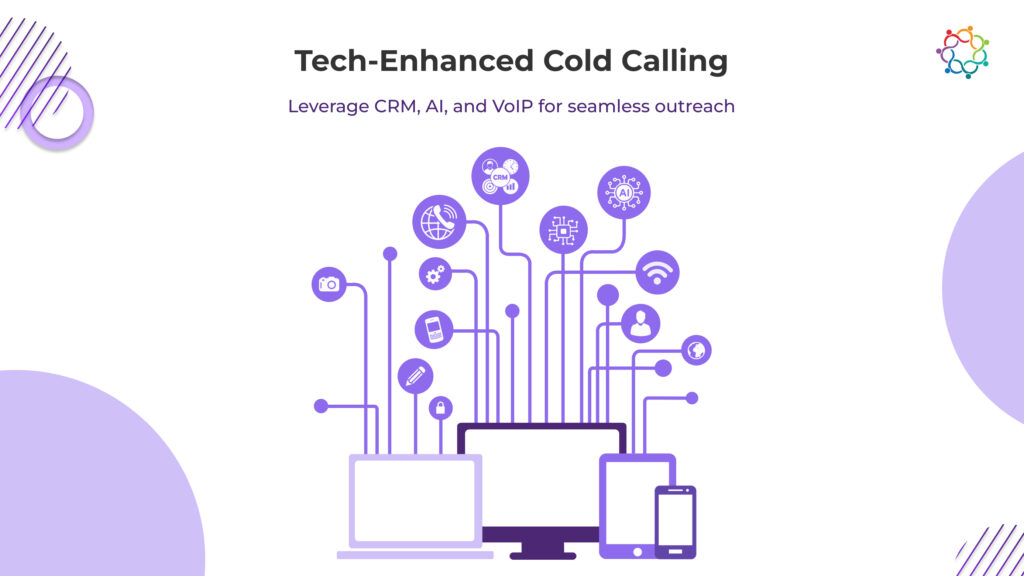
Technology has transformed cold calling from a manual, time-consuming process into a data-driven, highly efficient sales strategy. In 2025, integrating VoIP, AI-powered dialing, CRM systems, and analytics tools is essential for maximizing results.
With many sales teams operating remotely or on the go, mobile-friendly CRM apps and cloud-based call management systems allow reps to:
By integrating smart technology, cold calling becomes a more strategic, scalable, and results-driven sales approach.
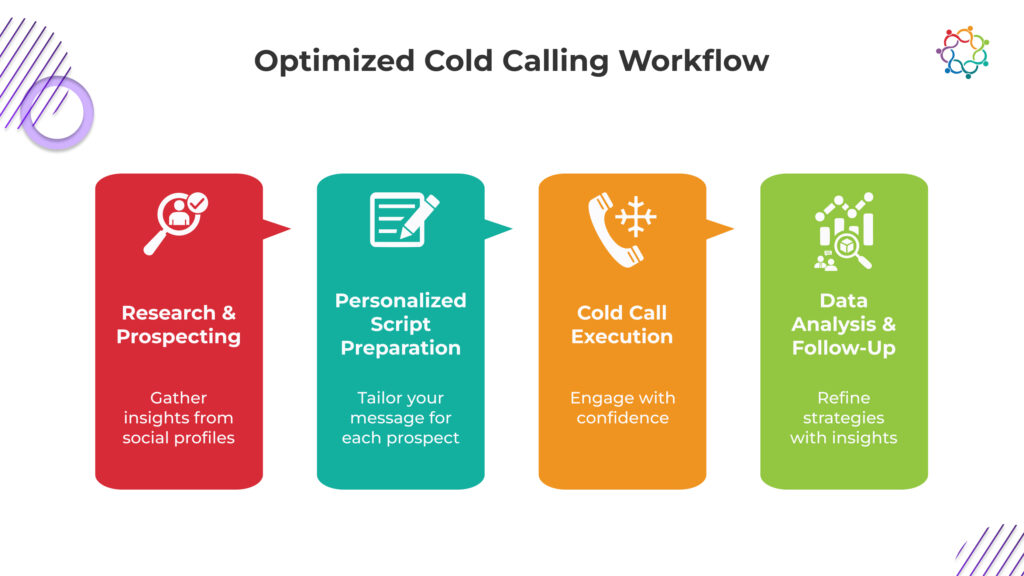
A well-structured script is the foundation of successful cold calling, but rigid, robotic pitches often fail. In 2025, personalized, flexible scripts tailored to buyer personas and pain points are essential for engaging prospects effectively.
Example 1: The Problem-Solution Approach
“Hi , I came across and noticed you’ve been actively running large-scale events. Many teams I speak with struggle with . How has that been for you?”
(Pause for response, engage in discussion)
“We’ve helped similar teams streamline by . Would you be open to a quick call next week to see how this could work for you?”
Example 2: The Question-Driven Approach
“Hi , quick question—how are you currently handling ?
(Let them answer, listen actively, and respond based on their pain points)
“We’ve worked with to help them achieve . Would it make sense to explore how we can help you as well?”
The key to a successful script is adaptability—sales reps should use these frameworks as guides but adjust based on each conversation.
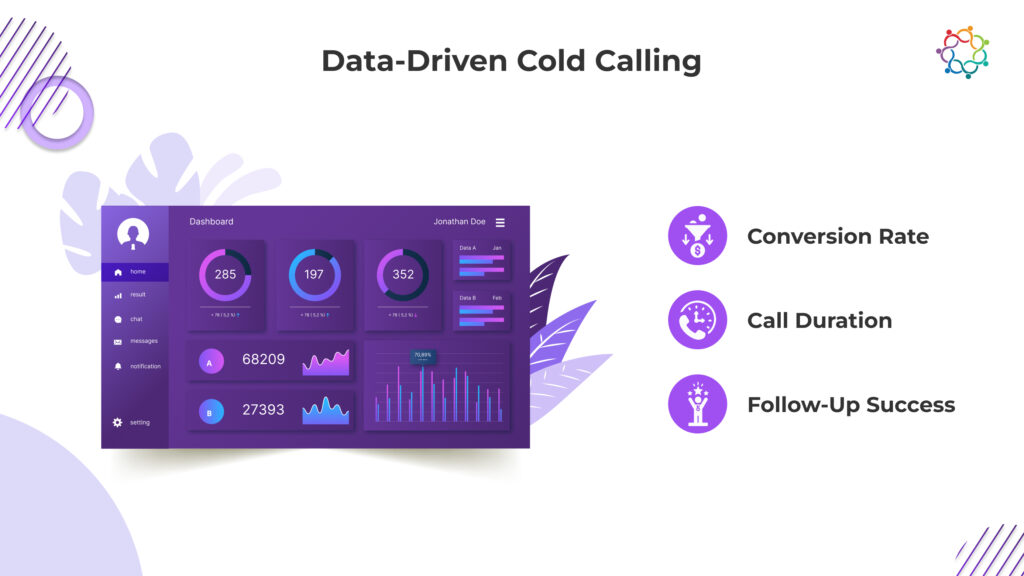
Cold calling is no longer a guessing game. With advanced analytics and CRM tracking, sales teams can leverage data-driven insights to optimize their approach and maximize conversions.
Key Cold Calling Metrics to Track
By using data to refine cold calling strategies, sales teams can increase efficiency, boost engagement, and drive more event registrations in 2025.
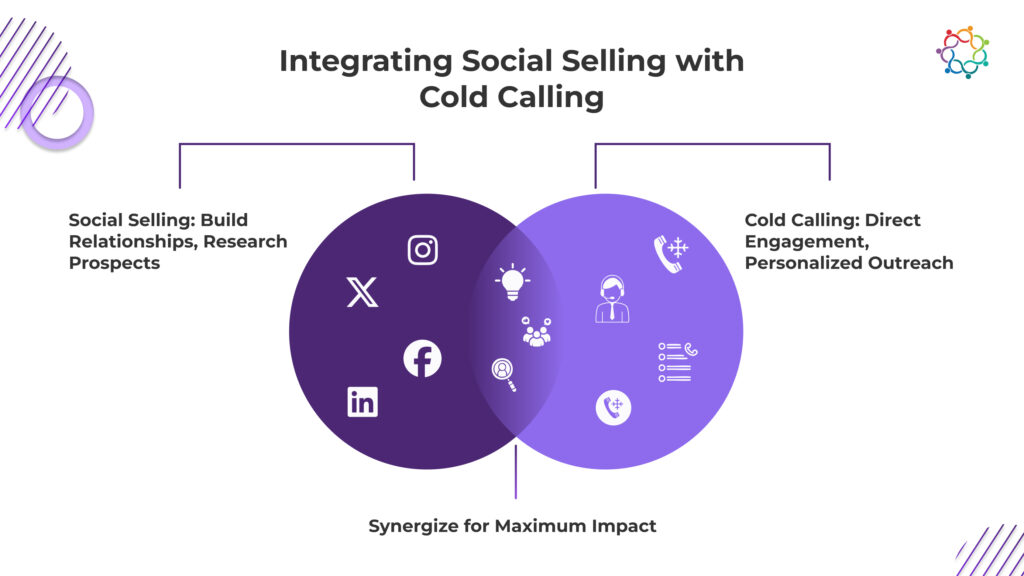
Cold calling is most effective when combined with social selling—the practice of engaging prospects through platforms like LinkedIn and Twitter before making a call. This multi-touch approach helps warm up leads, making them more receptive to sales conversations.
By combining social selling with cold calling, sales reps create warmer, more engaging conversations that improve conversion rates.
As technology evolves, cold calling is becoming smarter, not obsolete. The future will be driven by AI, automation, and continuous optimization based on real-time insights.
Cold calling in 2025 isn’t about dialing more—it’s about calling smarter, leveraging technology, and integrating multi-channel strategies to make every conversation count.
To successfully future-proof your cold calling strategy, it’s essential to put these insights into action. Here’s a step-by-step checklist to help you implement the strategies covered in this guide:
Combine Social Selling with Cold Calling
Next Steps: Start implementing these strategies today, experiment with different techniques, and refine your approach based on data-driven insights. The future of cold calling isn’t about dialing more—it’s about calling smarter.
Cold calling in event sales is evolving, but its core value remains—building meaningful connections and driving event success. By integrating personalization, technology, and data, sales teams can enhance their effectiveness and stay ahead of industry shifts.
The key to success in 2025 lies in adaptability—embracing new tools, refining approaches based on insights, and maintaining a human touch in every conversation.
At Samaaro, we empower event professionals with cutting-edge solutions to elevate their outreach and maximize event success. Ready to take your event sales strategy to the next level? Start implementing these techniques today and share your experiences with us!
In 2025, WhatsApp has solidified its position as an indispensable tool for event promotion. With its expansive user base and continuous introduction of interactive features, it offers unparalleled opportunities for organizers to engage potential attendees. WhatsApp groups, in particular, have emerged as a powerful channel to drive event registrations, fostering direct and personalized communication with target audiences.
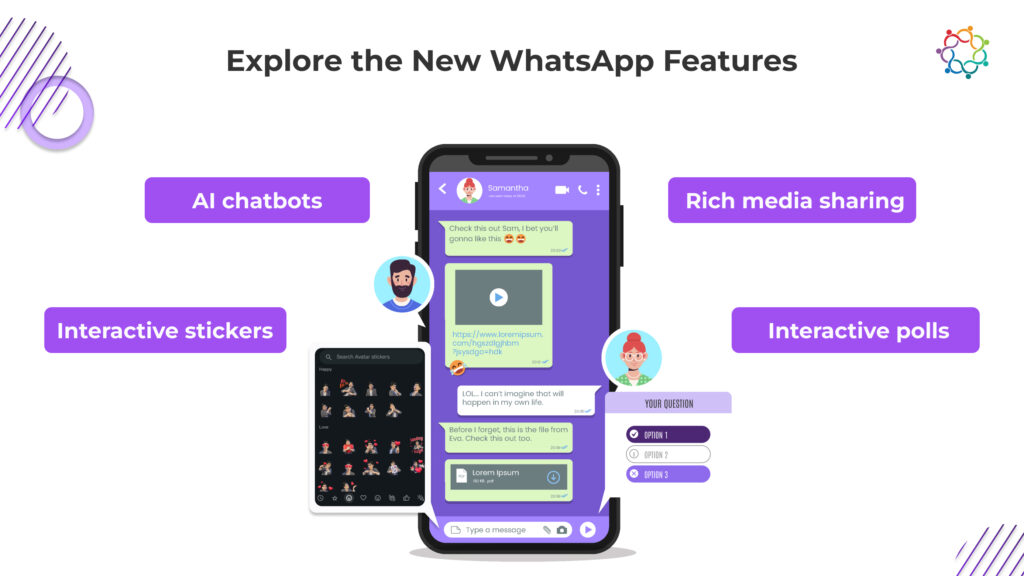
WhatsApp’s commitment to enhancing user experience has led to the introduction of several interactive features in 2025:
Leveraging these features within WhatsApp groups can significantly enhance event promotion efforts:
By strategically integrating these evolving features into WhatsApp group interactions, event organizers can create a dynamic and engaging environment that not only captivates potential attendees but also streamlines the registration process, ultimately maximizing event participation.
Effective audience segmentation and strategic group organization are pivotal in leveraging WhatsApp for event promotion. By categorizing your audience based on specific criteria, you can deliver tailored messages that resonate, thereby enhancing engagement and boosting registrations.
Once segments are defined, establish dedicated WhatsApp groups for each category:
To manage these groups effectively:
By thoughtfully segmenting your audience and organizing WhatsApp groups accordingly, you can deliver personalized and relevant communications that significantly enhance event registrations and attendee satisfaction.
Timing plays a crucial role in the effectiveness of your event promotion efforts on WhatsApp. Understanding when your audience is most receptive can lead to higher engagement and increased registrations.
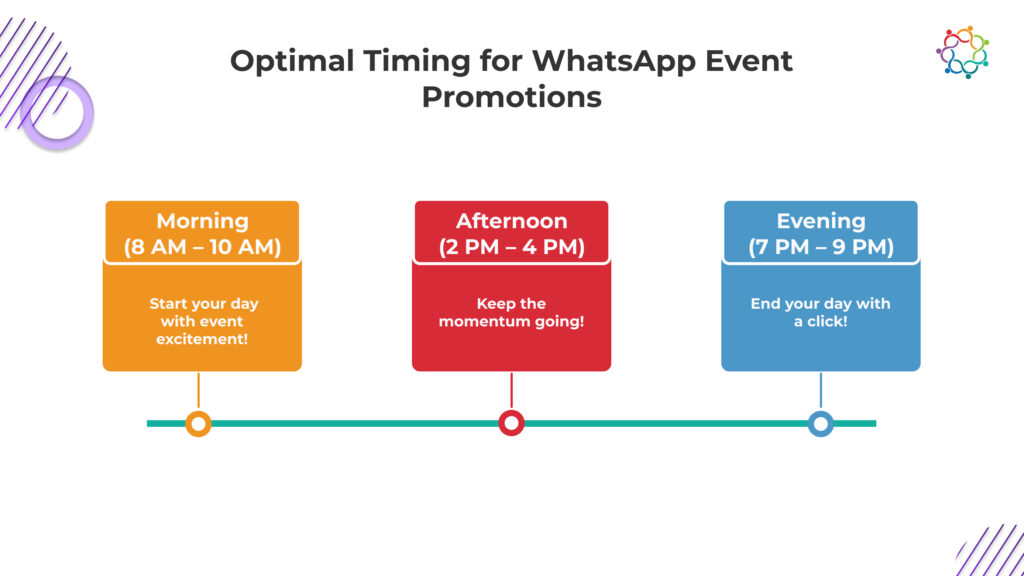
By strategically timing your messages and continuously optimizing based on audience behavior, you can maximize the impact of your event promotions on WhatsApp, leading to higher registration rates and successful events.
Leveraging WhatsApp Business can significantly enhance your event promotion efforts by providing tools designed for professional communication and audience engagement.
For larger events, integrating the WhatsApp Business API with your event management system or CRM can streamline communication:
By effectively setting up and utilizing WhatsApp Business features, you can create a professional and interactive platform that enhances event promotion and attendee engagement.
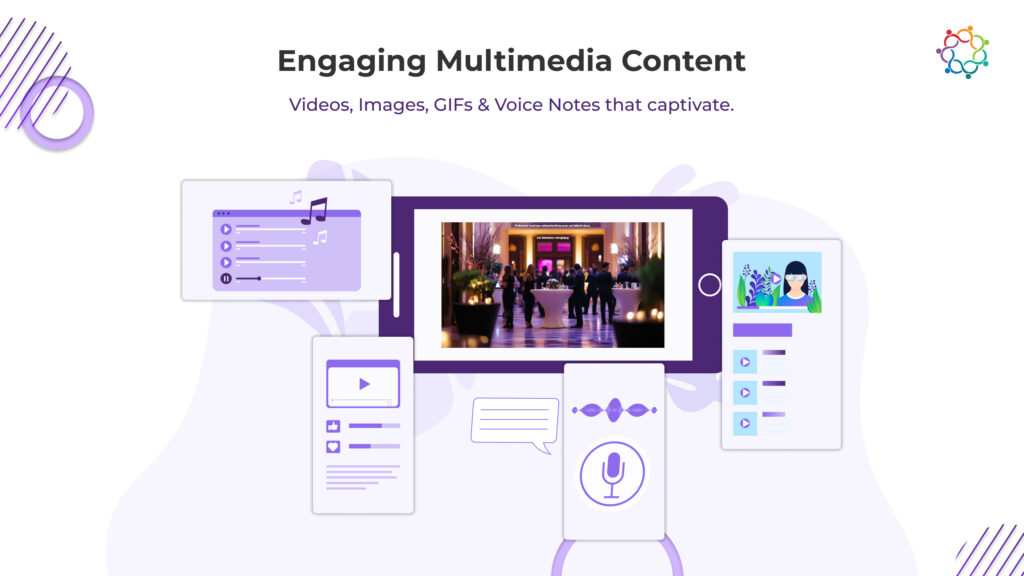
Incorporating high-quality multimedia content into your WhatsApp event groups can significantly boost engagement and motivate participants to register and participate actively.
By thoughtfully creating and sharing engaging multimedia content, you can capture the attention of your WhatsApp group members, encourage registrations, and foster a vibrant community around your event.
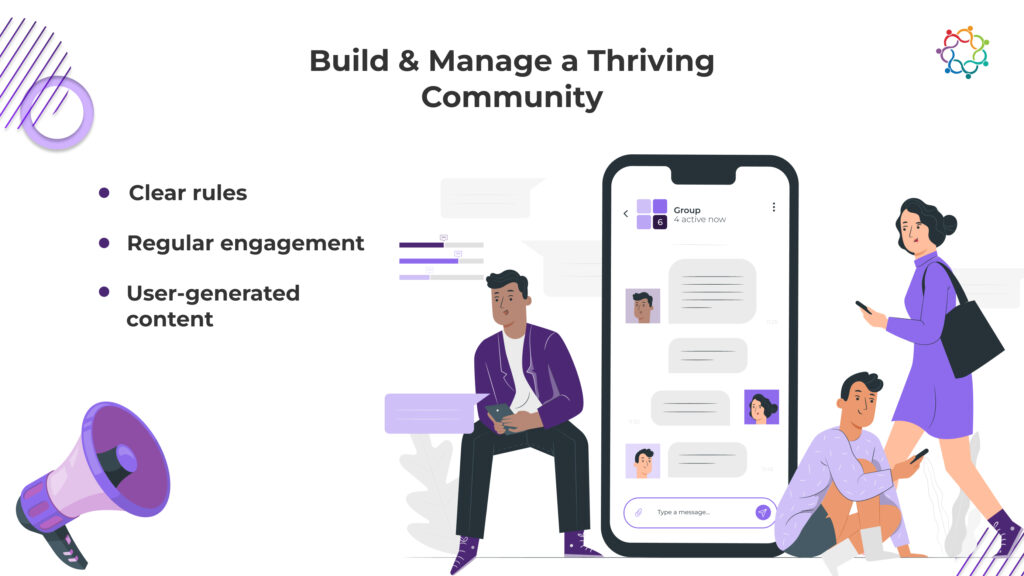
Effective community management is essential to maintain an engaging and respectful environment within your WhatsApp event groups.
By implementing these community management strategies, you can create a dynamic and supportive WhatsApp group that enhances attendee experience and promotes a successful event.
As WhatsApp continues to evolve, new features and technologies are shaping how event marketers leverage the platform for promotion and engagement.
WhatsApp has evolved into a powerful tool for event promotion, offering a direct, engaging, and interactive channel to drive registrations and community engagement.
By leveraging new features, audience segmentation, strategic messaging, engaging multimedia content, and community-building strategies, event marketers can maximize their reach and impact in 2025. With emerging trends like AI-driven automation, enhanced analytics, and omnichannel integrations, the platform is set to become even more valuable for event professionals.
Now is the time to implement these best practices and transform WhatsApp into a high-converting event marketing channel.
At Samaaro, we’re committed to empowering event marketers with cutting-edge solutions that drive engagement and success. Explore how our event marketing platform can help you make the most of WhatsApp and beyond.
Email marketing remains one of the most potent channels for event promotion. As we prepare for 2025, the world of email marketing is changing, faster than at any other time in history, mainly due to advancements in technology, AI-driven personalisation, and mobile-first innovations. For marketers, this means understanding how your strategies need to shift to meet the demands of that wonderfully diverse audience.
In this article, we are going to provide you with an all-encompassing guide on the best email marketing for event promotion in 2025. We will discuss everything from personalisation and automation to the latest in data analytics and list management. Whether you are planning a small workshop or a large conference, this guide will help you effectively engage your audience and increase registrations to your events.
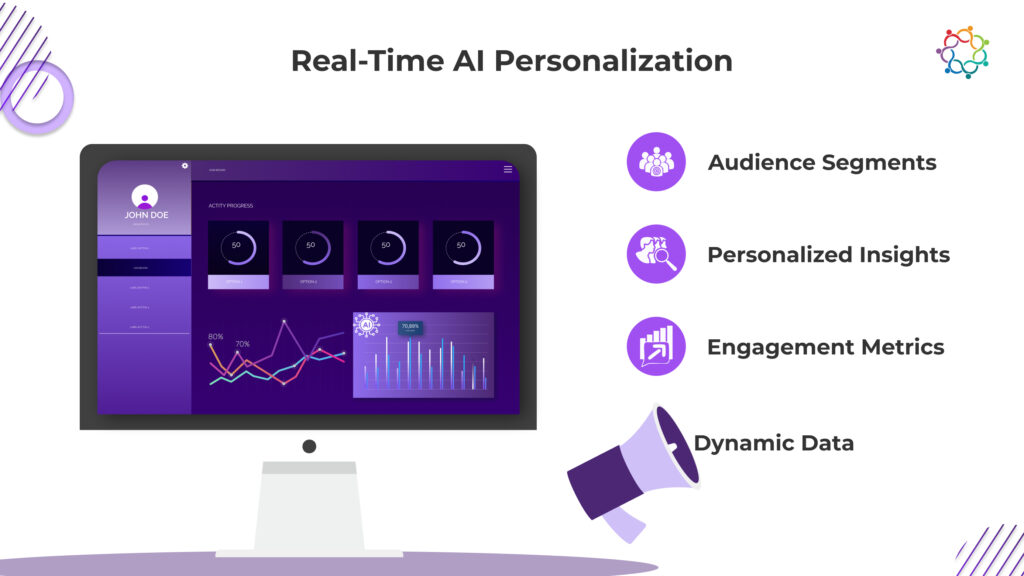
The data age of profiling our audiences means that one size will no longer fit all. Personalisation in email marketing has moved beyond inputting the recipient’s name. Successful email campaigns today personalize across multiple aspects, through dynamic content that considers a person’s specific interests and behaviours.
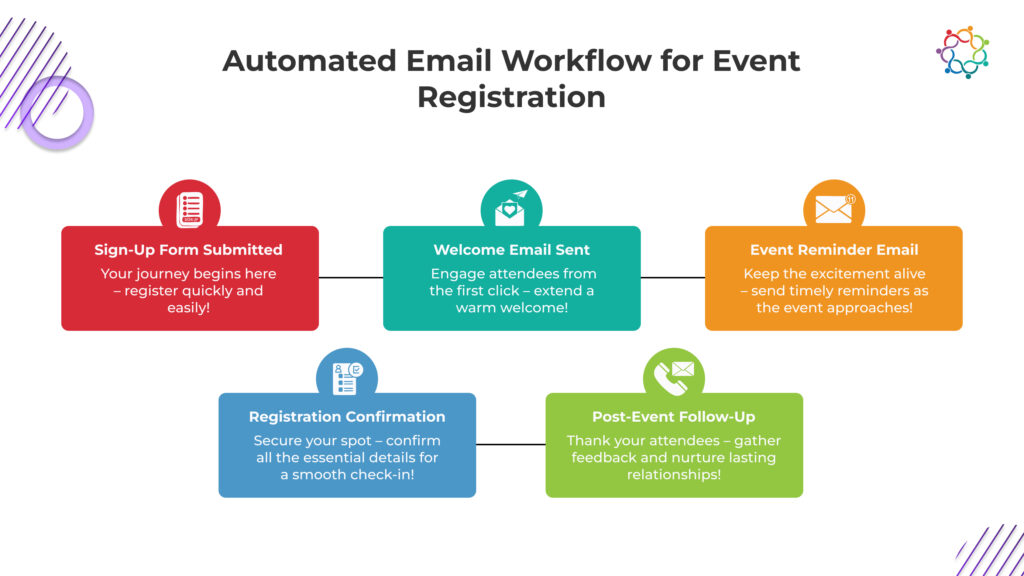
As events grow in complexity, there are ways to automated and AI technologies we can use to support future events and help streamline the registration process. This means you are spending less time and will ensure timely and relevant communication from your audience.
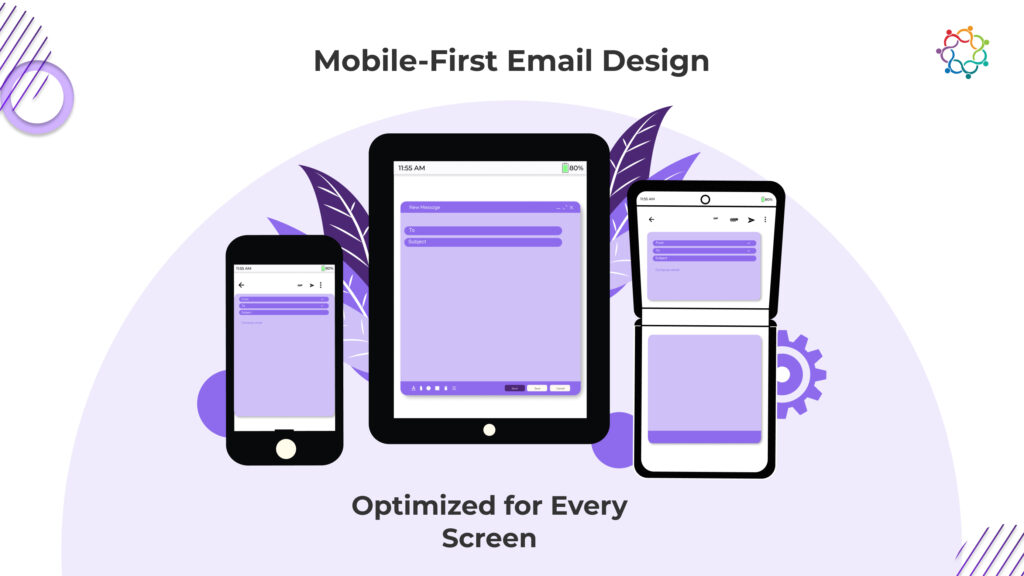
In 2025 mobile-first is no longer a trend, it is now essential. The number of people who access emails through their smartphones is ever-growing, as well as new emerging devices like smartwatches and foldable phones. Making sure that your email design is responsive and compelling on all screens will be crucial.
Data Analytics and Reporting/Tracking Performance in Email Marketing Campaigns in 2025:
Data what power and foundation in email marketing in this modern era! With advanced new data analytics abilities, you will be able to understand how your email marketing campaigns were performing and make data driven decisions based on your campaigns.
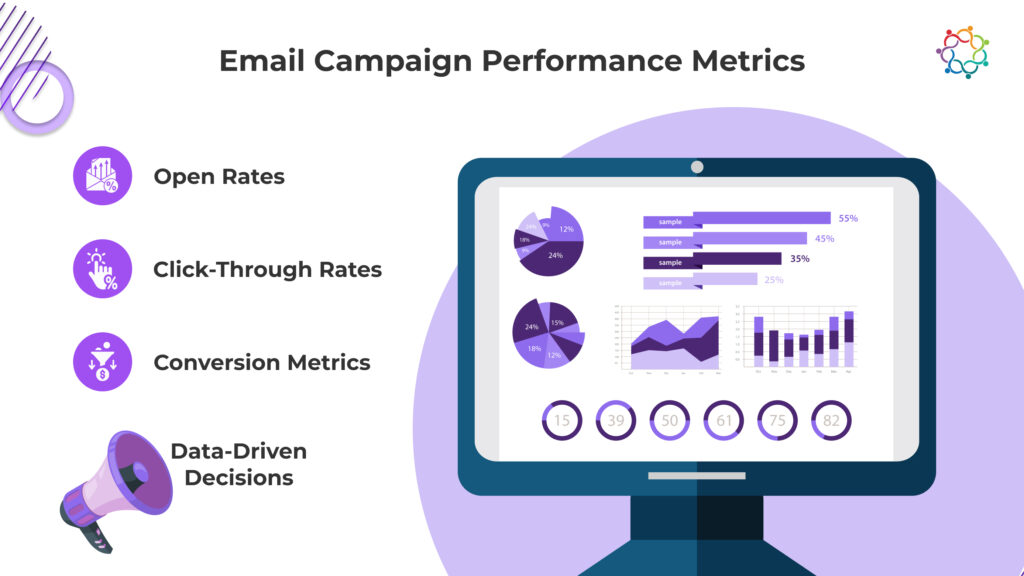
An area of email marketing that is often overlooked is list hygiene. It is very important to keep a clean and updated email list, to ensure deliverability and success with an email campaign.
Leveraging Emerging Trends and Technology
The future of email marketing is about leveraging emerging technologies for subscribers’ engagement in immersive and interactive experiences.
Email marketing continues to be a key part of event marketing – even in a world that will look quite different by the year 2025. By utilizing dynamic personalization, AI and automation, mobile-first design, and powerful data analytics, marketers can create campaigns that connect with many audiences. In addition, by keeping your email lists clean and updated, you can ensure that your message is reaching the right people at the right times, and by adopting new technologies, marketers can ensure that their email marketing strategies will not be left behind.
As you develop your email marketing plan for the next few years, keep in mind the take-ways here:
Utilizing the strategies above will not only yield increased engagement and registration rates but will position your brand as being forward thinking in the world of event promotion email campaigns. Start planning now to ensure your strategy can meet the opportunities that await us come 2025.
In 2025, the changing face of email marketing is changing how events will be promoted, with features including AI-enabled personalization and automation, mobile-first design, and powerful data analytics.
Embracing these tools is critical, not only to help you reach your audience’s attention but to increase your audience’s engagement and registration rates.
At Samaaro, we are committed to providing an all-in-one platform, to help event organizers utilize the advanced tools of email marketing.
With our enablement tools, we make it simple to create the types of dynamic, personalized emails that create conversations with various audiences, streamline the process for event registrations, and real-time insights to assess and refine subsequent marketing campaign strategies.
By working with Samaaro, you guarantee your event promotion strategies stays current, scalable, and built around tools that can help make the measurable results. Get ready to take email marketing for events to a higher level and improve your events with Samaaro – Book A Demo or Trial Today!
Salesforce is an incredibly powerful Customer Relationship Management (CRM) software that has transformed how businesses manage customer interactions, sales, and marketing efforts. Salesforce’s versatility has become applicable to the events industry as well. What Salesforce can do, is merge event planning, marketing, sales, and attendee engagement seamlessly!
By utilizing Salesforce to its fullest extent, event planners can manage leads, automate your marketing campaigns, manage your event performance effectively and enhance the customer experience and engagement of attendees. Through this blog, we are exploring how Salesforce can help you to achieve successful events and higher ROI.
I. Managing Leads with Salesforce
Lead management plays a vital role in maximizing event ROI. Salesforce provides many tools for lead capturing, scoring, nurturing, segmentation, and tracking that enable teams to convert event attendees to customers.
Effortless Lead Capture
Salesforce can integrate with event registration forms, mobile apps, and on-site check-ins to:
Having a 360 degree view of every attendee helps a sales and marketing team know how to best make a move.
AI Lead Scoring
If leads are appropriately prioritized, sales teams spend time addressing the leads that will make the most significant impact. Salesforce’s AI lead scoring allows lead to have
Having this information, the sales team can identify the leads around interest for personalized follow-up.
Automated Lead Nurturing
After the event, it’s all about keeping the leads engaged and taking action to drive conversion. Salesforce gives users automation tools that allow for
With automated workflows, event planners will be able to keep leads warm while also ensuring sales teams are not constantly following up with leads manually.
Advanced Lead Segmentation
Salesforce allows event planners to separate leads into meaningful segments for more targeted follow-up such as:
With leads segmented by behavior and characteristics, marketing can deliver more vibrant campaigns and sales will have better pitches.
Visibility into Real-Time Lead Progression and Sales Collaboration
Salesforce’s lead tracking and reporting tools give full transparency into attendees on their journeys from registration to post-event action. Key benefits include:
Sales teams and marketing will be all on the same page by using Salesforce which will help speed the conversion.
Tracking Sales Opportunities in Salesforce
In addition to lead management, Salesforce gives event organizations tracking tools to monitor all revenue opportunities as they are generated (tickets, sponsorships, exhibitors, and partnerships).
Visibility into the Entire Opportunity Cycle
Salesforce allows groups to see all stages of sales from initial stages to closing the deal. Key features include:
By organizing sales opportunities in Salesforce, event teams can ensure that opportunities for revenue are not missed.
Real-time pipeline visibility with the pipeline tools in Salesforce, event teams can:
Customizable sales reporting Using Salesforce’s reporting capabilities, event teams can:
With custom reports, sales teams can always be looking at their techniques to improve upon their return on investment (ROI).
Seamless integration with Sales Cloud Salesforce
Sales Cloud helps event teams ensure that sales-related data from events flows effectively between teams:
This integration improves efficiencies and ensures sales opportunities are not missed.
Dynamic Dashboards for Data Visualization
Salesforce dashboards enable event teams to visualize, track, and analyze data across multiple metrics and KPIs.
Salesforce dashboards help event planners remain data-driven in their efforts for event revenue management.
Automating Event Marketing Tasks with Salesforce
Marketing automation in event marketing is targeted at scaling your outreach and increasing attendee engagement that leads to a conversion outcome. Salesforce has tools powered by automation to help event teams expand their marketing planning and execution and allows them to measure their success for accountability.
Automated Email Marketing:
Salesforce has automated email campaign capabilities to ensure event managers are communicating to their attendees before, during the event, and after it is planned. Key elements of benefits include;
Having an automated (email) workflow would allow you to automate all the attendee email communication phases to keep the attendee experience engaged and increased follow-ups
Social Media Management
Salesforce allows event teams to structure and manage their social media communication and promotions for their events while in one place.
Adding social media tracking into Salesforce will be easy and will be less thinking for event marketing teams while engaging with audiences across various formats!
Marketing Analytics / Measuring Campaign Effectiveness
Improving and optimizing event marketing to be effective and tracked on campaign effectiveness by using Salesforce would support event marketers in;
Event marketers will not have to guess if the marketing tactics they used functioned.
– Automating Automated Workflows
Salesforce allows event marketers to automate that will save time and manage ongoing duties/tasks as well:
Will make the system easier to keep the workflow as attendees are grouped accurately.
By having repetitive tasks automated, you are going to give some time back to dying both as well put that time into strategy, initiatives, and delivering an incredible attendee experience.
Tailored AI Personalization
Salesforce employs intelligent AI and its capabilities will provide;
AI-powered personalization maximizes attendee engagement and fosters and amplifies outcomes like event conversion rates that are persistently focused on your stakeholders.
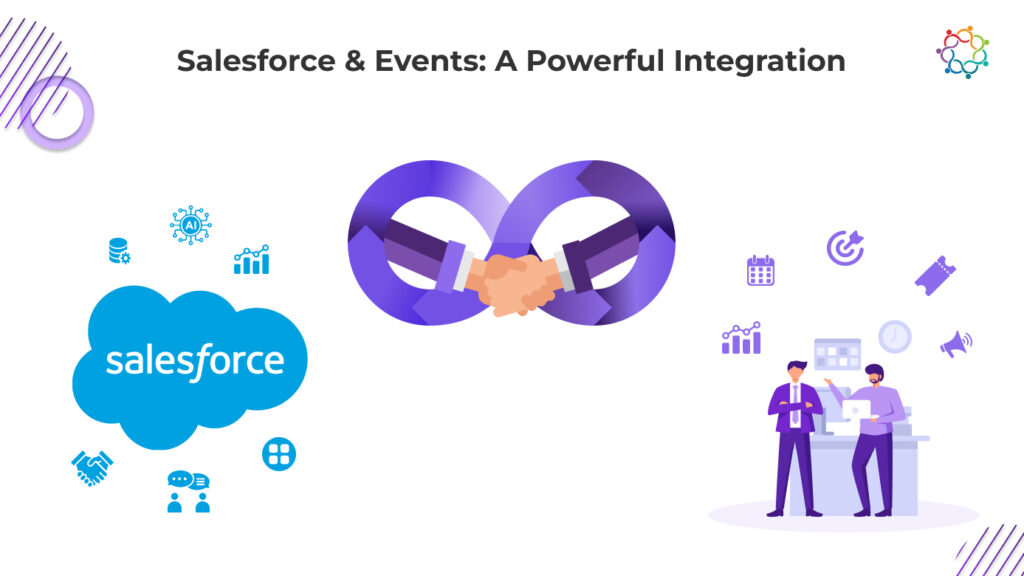
When Salesforce is seamlessly integrated with your event technology, you end up getting a good experience for everyone involved; the attendees, the organizer, and the sales team. When businesses tie together Salesforce and event technology tools, they can bring data together, operate more efficiently, and enhance engagement.
Integrations with Event management Platforms
Event management platforms such as Cvent, Bizzabo, and Eventbrite offer a variety of options for integrating with Salesforce. Integrations provide you with the ability to:
In regards to event management platforms, integration with Salesforce equals efficiency and removes data silos.
Integrations with Mobile Event Apps and On-Site Engagement tools
By integrating with mobile event apps, and after event management processes, staff will obtain real-time insight on attendee engagement and track engagement interactions, including:
Integrating mobile event apps ensure that everything an attendee interacts with is logged as event interactions, thereby creating a better basis for personalized engagement.
Integrating Marketing Automation Tools
When linking your marketing automation tool platforms like HubSpot, Marketo, or Pardot, to Salesforce provide operational enhancements for better market events by:
With promotional solutions, the event team can streamline lead collection and improve conversion.
Data Moving Through Systems
When event tech and Salesforce share data flow, it can:
Having all data flowing in one complete ecosystem allows for better fundamental decisions and better execution of events overall.
API’s and/or Customized Event Tech
Salesforce APIs provide organizations with the ability to connect to customized software and/or third-party event tech solutions by enabling:
Using Salesforce APIs allow organizations to build custom scalable event tech solutions that measure directly to their goals.
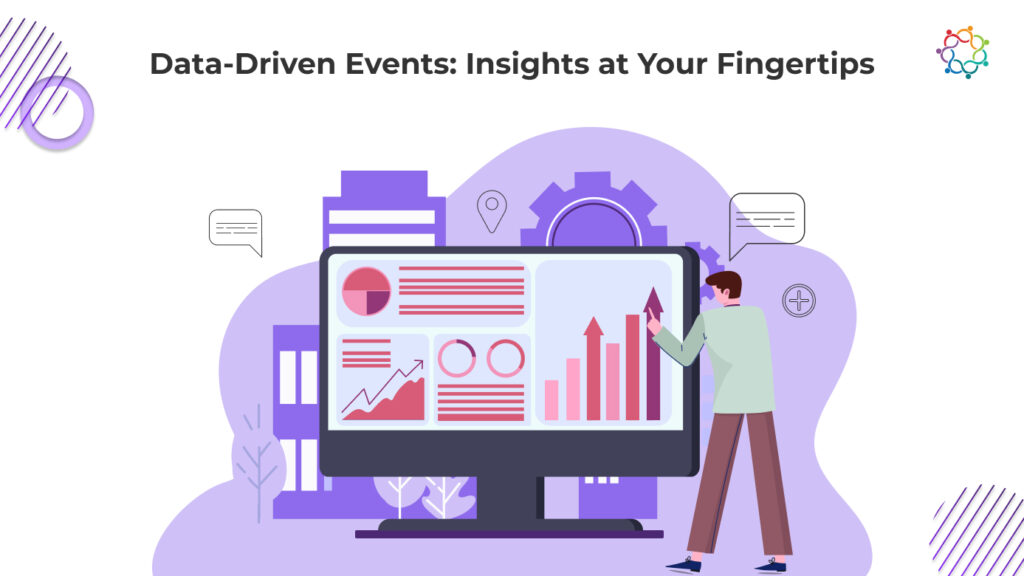
Data is at the core of a successful event, and Salesforce is equipped with strong reporting and analytics capabilities to help the event planner measure, refine, and get the most return on their investment.
Customized Reporting for Event Data Insights
Salesforce will allow your organization to create reports based on:
Attendee Patterns: Attendance at sessions, level of engagement, and opportunities to network.
Lead Conversion: Track the intended path from a lead being seized to it converted, as well as the touchpoints along the journey.Sponsorship Performance: Measuring sponsor visibility, audience engagement, and lead generation.
Event Metrics: Participation, ticket, engagement accords.
By having access to important event analytics in real-time, event organizers can make informed event decisions to improve their next event.
Event Data Visualization for Real-Time Positioning
Salesforce dashboards allow teams to:
Track KPIs: Monitor registration numbers, session attendance levels, and lead engagement, all in an interactive environment.
Understand Event Performance in 360°: Utilize real-time visual reports to capture a moment in event success.
Look for improvement opportunities: Identify attendee vendor engagement behavior and track a more effective marketing approach.
If event teams can visualize their data, they will be able to comprehend complex information using raw data and identify areas where they can act.
ROI Assessments for Event Planning
Salesforce ROI Assessment Tools help organizers:
Determine Campaign Performance: Measure marketing effectiveness comparing the success/ROI of pre-event campaigns across numerous outlets (channels).
Understand the Performance of the Sponsor/Sponsorship: Analyze sponsor visibility and engagement to develop the sponsorship package.
Drive Better Budget Decisions: Utilize data insights to plan spending in areas previously yielding positive returns and removing)or attempting to prevent investment in less effective return producer.
By analyzing event ROI on a continuous basis, organizations can improve financial accuracy and guarantee the long-term success of the event.
Data-Driven Best Practices for Continuous Improvement
Using Salesforce analytics will allow event organizers to:
Improve Audience Engagement: Analyze attendee engagement data to determine the level of experience you provided; personalize and simply engage with more attendees.
Improve Planning of future events: Use previous event insights to better plan their subsequent events: venue choice, session topics and content delivery.
Enhancing Sales and Marketing Alignment: Ensure that your sales and marketing teams are leveraging data to continuously optimize their lead tracking and conversion processes.
Real-time analytics allow your event marketing teams to continuously shift their activities.
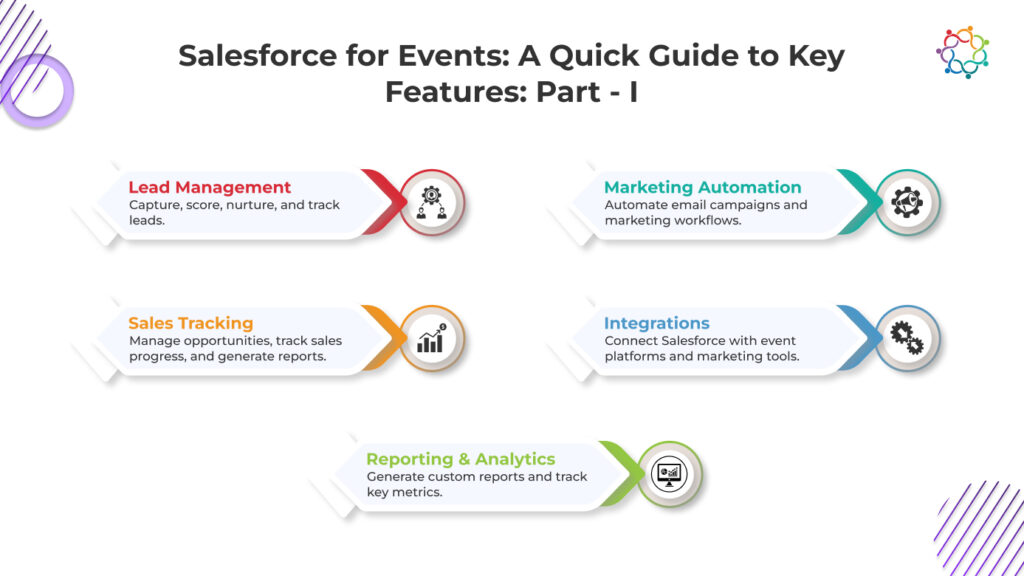
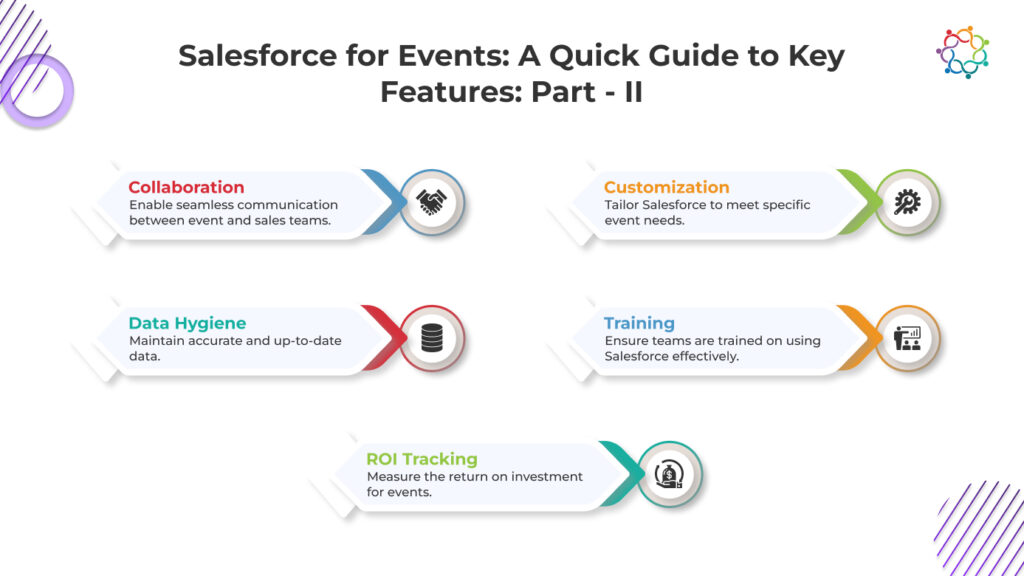
Organizations can utilize best practices to help them take advantage of Salesforce as well as provide teams with effective workflows, better data accuracy, and ultimately overall effectiveness.
1. Data Hygiene:
2. Training and Adoption:
3. Customization:
4. Integration Strategy:
5. Ongoing optimization:
Utilizing these best practices will allow your organization to fully maximize the effectiveness of using Salesforce in your strategy around events.
Conclusion
Salesforce is an absolutely game changer for event planning and event management for organizations around lead capture, optimizing marketing automation, sales alignment, and so much more; real-time analytics is what allows your event planners to increased engagement, improved efficiencies, and ultimately better revenue. We at Samaaro, know the need for organizations to leverage CRM technology to rethink their event strategy. Request a demo or start your free trial today to see how Samaaro can change your event experience for the better.
Traditionally, sales and event teams have operated in silos, with minimal collaboration beyond sponsorships or lead generation. However, in today’s competitive landscape, integrating sales into the event planning and execution process can drive significant revenue growth and enhance attendee experiences.
By aligning goals, improving communication, and leveraging each team’s expertise, organizations can maximize event ROI, improve customer relationships, and create high-impact experiences. In this blog, we’ll explore how breaking down silos, integrating sales into event planning, and optimizing sponsorships can transform your event strategy into a revenue-generating powerhouse.
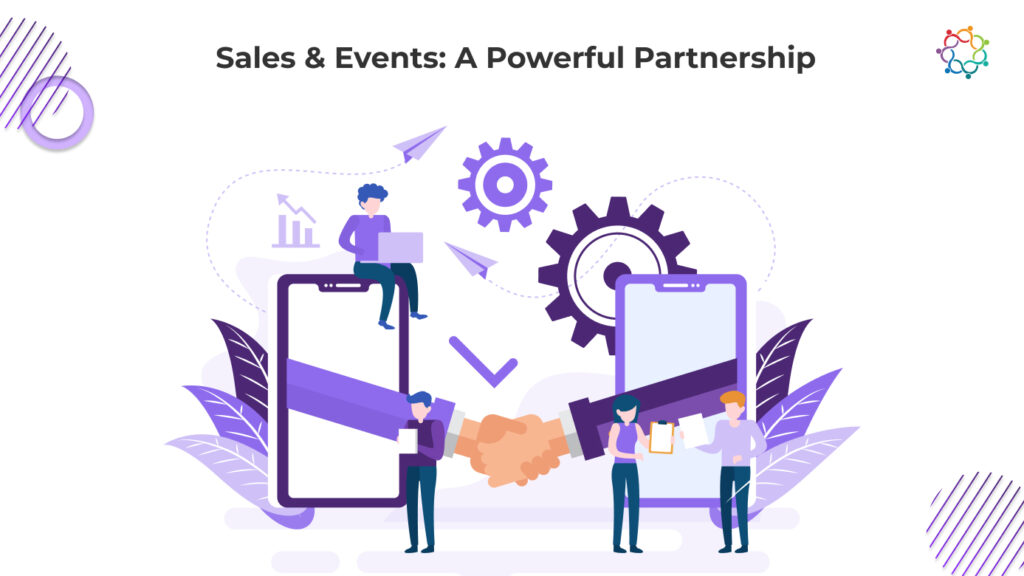
In many organizations, sales and event teams operate in silos, with separate objectives, tools, and strategies. However, true event success comes when these teams collaborate, aligning their efforts to create a seamless, engaging experience that drives meaningful business outcomes. By fostering open communication, shared goals, and cross-functional teamwork, companies can maximize the value of their events and create stronger connections with their audiences.
To work effectively together, sales and event teams need a unified vision. Instead of viewing events as isolated marketing activities, both teams should align around key objectives such as:
When both teams align on these core objectives, events transform from standalone initiatives into powerful business growth drivers.
One of the biggest challenges in collaboration is miscommunication. Sales and event teams often operate with different timelines, tools, and priorities, leading to missed opportunities. Establishing clear communication channels ensures that both teams:
By streamlining communication, sales and event teams can eliminate confusion and work together more efficiently.
Rather than operating as separate entities, companies can foster collaboration by forming cross-functional teams that include members from both sales and event departments. This approach:
By integrating team members into a unified working group, companies can break down silos and foster a more cohesive approach to event execution.
When sales and event teams collaborate effectively, the customer experience becomes more personalized, seamless, and impactful. A well-coordinated approach ensures that:
This level of coordination creates a frictionless journey for attendees, increasing the likelihood of meaningful connections and long-term relationships.
Collaboration also enables better measurement and optimization of event performance. When sales and event teams work together, they can:
With a collaborative mindset, sales and event teams can not only drive stronger event results but also refine their strategies for long-term success.
Breaking down silos between sales and event teams isn’t just about improving efficiency—it’s about creating more meaningful, impactful event experiences that drive real business value. By aligning goals, improving communication, fostering cross-functional teamwork, and delivering seamless customer interactions, companies can unlock the full potential of their events. When sales and event teams work together as true partners, the result is stronger relationships, higher engagement, and measurable success.
For events to drive real business impact, sales teams must be involved from the very beginning. Their deep understanding of customer needs, industry trends, and revenue goals makes them invaluable in shaping event strategy. By integrating sales into event planning, organizations can ensure their events are not just engaging experiences but also effective revenue-generating opportunities.
Bringing sales teams into the event planning process early allows for a more strategic approach. Sales teams can provide insights on:
By collaborating from the start, event planners and sales teams can create events that resonate with attendees and drive meaningful conversations.
Sales teams have a wealth of information about customers and prospects, including their needs, preferences, and buying behaviors. Leveraging this data allows event organizers to:
A data-driven approach ensures that attendees get maximum value from the event, increasing engagement and brand affinity.
Sales teams have established relationships with key industry players, making them valuable partners in securing event sponsorships. They can help:
A strong sponsorship strategy enhances event funding, resources, and overall experience for attendees.
A well-defined lead generation strategy requires close collaboration between sales, marketing, and event teams. Together, they can:
This structured approach ensures that leads gathered at the event translate into real business opportunities.
Events are prime opportunities for direct engagement with prospects. Sales teams can drive meaningful interactions through:
By integrating sales activation opportunities into the event, organizations can drive immediate and long-term revenue growth.
The success of an event isn’t just measured by attendance—it’s measured by post-event conversions. To ensure effective follow-up, sales and event teams should:
A strong post-event strategy ensures that leads don’t go cold and that events contribute directly to business growth.
Even the best event strategy falls flat without an empowered sales team. Organizations must equip their sales teams with the right tools, knowledge, and support to maximize event-generated opportunities.
Sales reps need to be well-versed in event themes, product offerings, and key messaging to engage attendees effectively. Pre-event training should cover:
Well-prepared sales teams can confidently navigate event conversations and position solutions effectively.
Sales teams need engaging, informative content to support their conversations. Essential sales collateral includes:
Having readily available sales materials ensures reps can provide valuable information on the spot.
Seamless CRM integration is crucial for tracking and managing event-generated leads. Best practices include:
With an integrated system, sales teams can efficiently nurture and convert leads without manual data entry delays.
Providing on-site support enhances sales effectiveness during events. Organizations should offer:
These resources ensure that sales teams can make the most of every interaction.
To continuously improve event-driven sales efforts, tracking key performance metrics is essential. Organizations should monitor:
By analyzing these insights, sales and event teams can refine strategies for future events, ensuring continued success.
Integrating sales into the event planning process and providing the right enablement tools transforms events from simple brand awareness activities into powerful revenue-driving opportunities. When sales teams are involved from the start, equipped with the right resources, and supported with seamless lead management, events become a catalyst for business growth. The key to success lies in collaboration, strategic planning, and continuous optimization—ensuring that every event delivers tangible results.
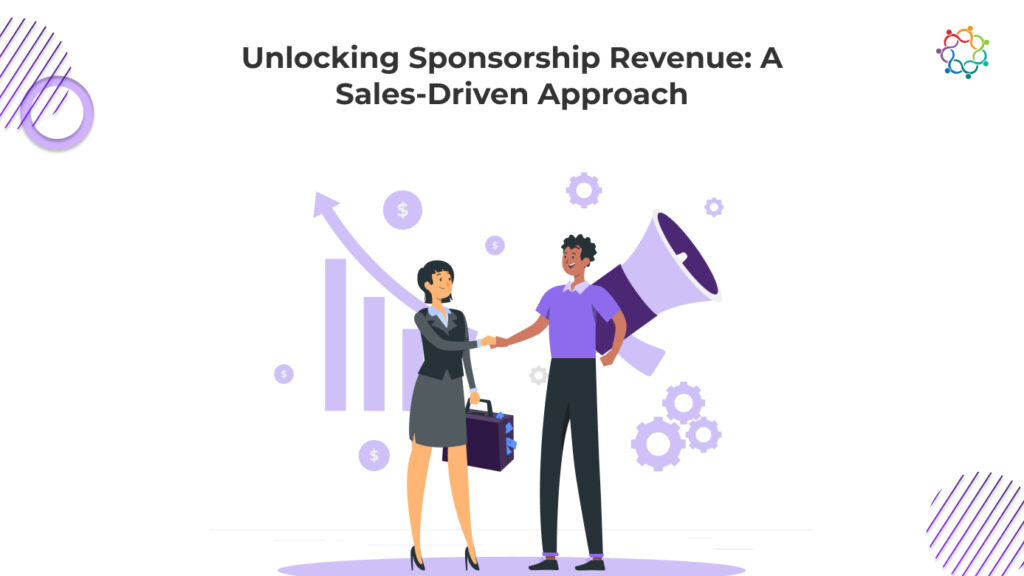
Sponsorships are a critical revenue stream for events, providing financial support while offering sponsors valuable brand exposure and lead generation opportunities. To maximize sponsorship success, sales teams must take a strategic approach to identifying, securing, and managing partnerships.
Sales teams have deep relationships within the industry, making them well-positioned to:
A targeted approach ensures that sponsorship opportunities align with attendee interests, maximizing value for all parties.
A one-size-fits-all approach to sponsorships no longer works. Sales and event teams should collaborate to create tailored sponsorship packages that offer:
By designing diverse sponsorship packages, organizers can appeal to a broader range of sponsors while enhancing the event experience for attendees.
Sales teams play a key role in structuring sponsorship agreements that are beneficial for both sponsors and event organizers. Key considerations include:
A well-negotiated sponsorship agreement leads to long-term partnerships and repeat sponsorships for future events.
Sponsorship success goes beyond securing deals—it requires ongoing relationship management. Best practices include:
Maintaining strong sponsor relationships leads to higher retention rates and increased sponsorship revenue over time.
Measuring Sponsorship ROI: Demonstrating Value to Secure Future Deals
To ensure continued sponsorship success, it’s crucial to track and report on key performance indicators, such as:
Providing sponsors with detailed post-event reports showcasing their impact helps secure renewals and expand sponsorship opportunities in future events.
A successful event isn’t just about attendance—it’s about the tangible business outcomes it delivers. Sales teams and event organizers must track key metrics to assess event effectiveness and optimize future strategies.
To measure the effectiveness of sales-driven event strategies, organizations should monitor:
These insights help sales teams refine their engagement strategies and prioritize high-value opportunities.
Event ROI isn’t just about revenue—it’s about efficiency and impact. Businesses should evaluate:
A data-driven approach ensures that events remain a profitable and strategic investment.
Continuous improvement requires feedback from multiple sources:
By leveraging feedback, organizations can refine event strategies and enhance sales effectiveness for future engagements.
Using Data to Optimize Strategies: Driving Continuous Improvement
Post-event analysis shouldn’t just be a review—it should drive actionable changes. Businesses can use event and sales data to:
Continuous optimization ensures that each event builds upon past successes, delivering greater value to attendees, sponsors, and sales teams.
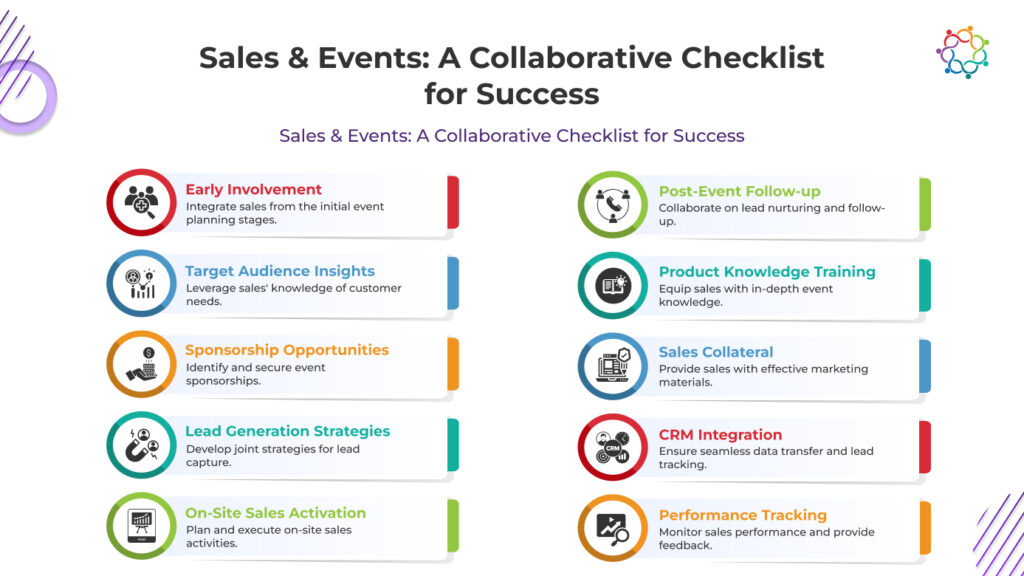
The synergy between sales and events is essential for maximizing business impact. By breaking down silos, integrating sales into event planning, and leveraging sponsorship opportunities strategically, organizations can transform events into powerful revenue-generating platforms.
A strategic and data-driven approach ensures that events generate not only leads but also long-term customer relationships and measurable business growth. Implementing these strategies with a platform like Samaaro can streamline processes, improve sales alignment, and maximize event ROI.
Book a demo or start your free trial today to see how Samaaro can help you turn your events into revenue-driving opportunities.

Built for modern marketing teams, Samaaro’s AI-powered event-tech platform helps you run events more efficiently, reduce manual work, engage attendees, capture qualified leads and gain real-time visibility into your events’ performance.
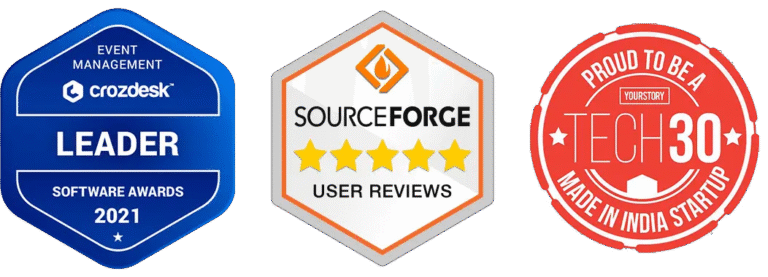
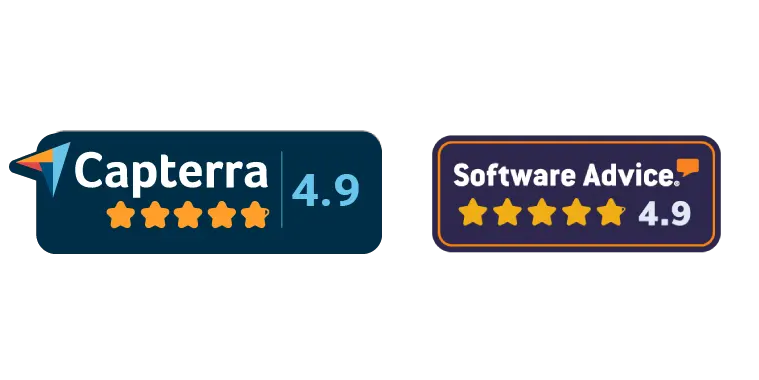
© 2025 — Samaaro. All Rights Reserved.